This simple mains 220 V, 110 V AC voltage home protector circuit will protect all the mains operated appliances of your home from high and low voltage situations and also from sudden voltage surge.
The circuit can be used with 220 V AC inputs and also with 110 V AC inputs.
The circuit will basically provide the following two types of protection to all your home appliances:
- Protection against high and low mains voltages.
- Protection against sudden voltage switch ON surge whenever AC mains restores after a brief voltage failure.
This circuit performs incredibly well and is highly suitable for home appliances.

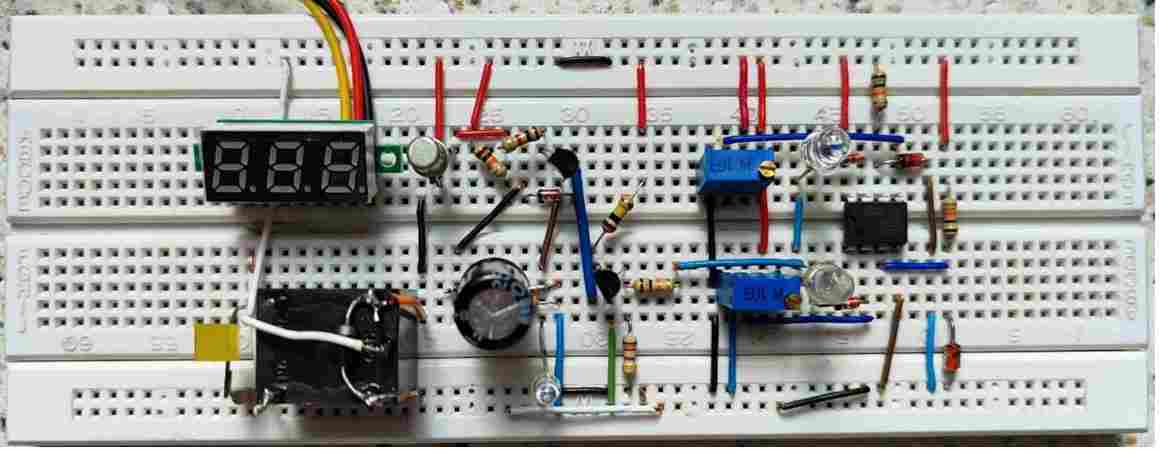
Circuit Description
With reference to the following diagram, the working of the proposed AC mains home protector circuit can be understood with the help of the following points:
Parts List
- All Resistors are 1/4 watt CFR 5%
- R1, R2, R4, R5 = 10k
- R3 = 4.7k
- R6 = 22k
- P1, P2 = 10k presets.
- Capacitors
- C1, C2 = 1000uF/25V Electrolytic Capacitors
- Semiconductors
- Diodes D1, D2, D3, D4, D7 = 1N4007
- Diodes D5, D6, D8 = 1N4148
- Zener Diodes Z1, Z2 = 4.7V, 400mW
- Transistors T1, T2 = BC547
- IC op amps A1, A2 = 1/2 IC LM324, or LM358 (pinouts will change accordingly)
- Transformer TR1 = 0-12V, 500mA
- Relay = 12V SPDT 30 amp
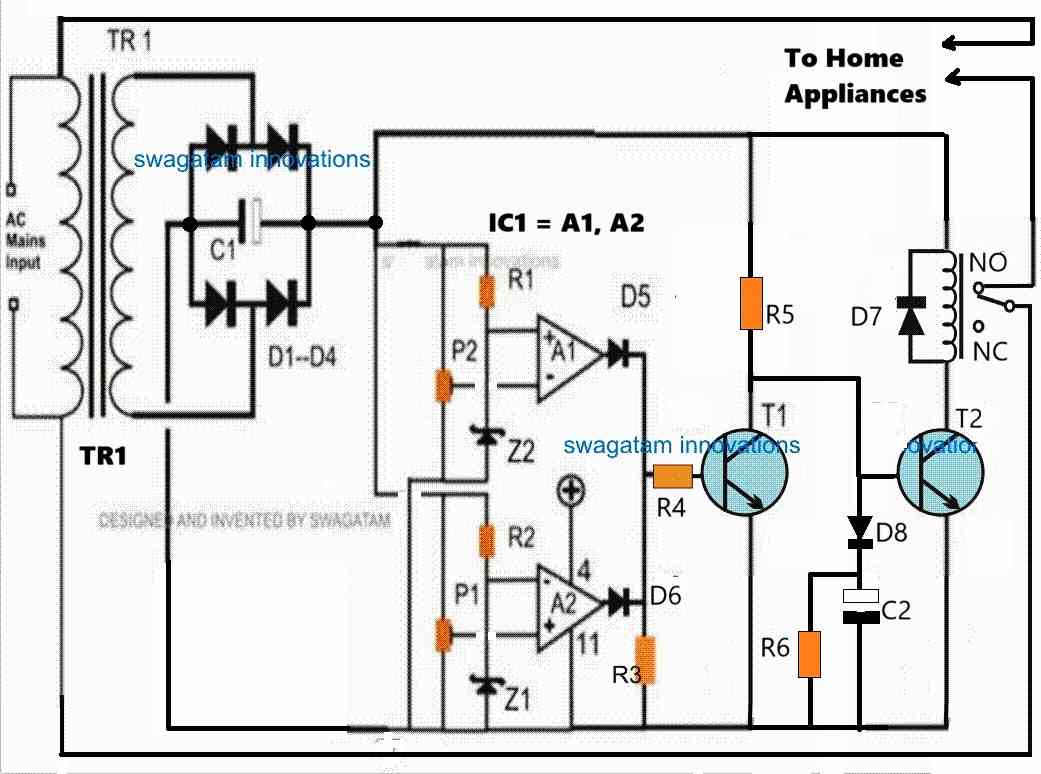
The two op amp comparators form the heart of the circuit which are configured as a window comparator for sensing the over and under voltage thresholds.
Window Comparator
A window comparator circuit is usually built using two op amps. One op amp is configured to sense the upper voltage limit threshold and the other op amp is configured to sense the lower voltage limit threshold.
Whenever the upper or the lower voltage limit thresholds are exceeded, the relevant op amp output goes high.
On the other hand as long as the voltage level stays within the safe limits, both the op amp outputs remains logic low or turned OFF.
In our home protector circuit, the upper op amp A1 is configured to sense the low voltage threshold, while the lower op amp is wired to sense the high voltage threshold.
For op amp A1, its non-inverting pin is clamped to a fixed voltage reference using a zener diode, while the inverting input is configured with a preset to sense the lower voltage threshold.
As long as the transformer DC (which is proportionate to the mains AC level) at the inverting input of A1 stays above the non-inverting pin's reference voltage, the output of A1 remains at 0V.
However, in an event when the input voltage at the inverting pin goes lower than the reference voltage at the non-inverting input, causes the output of A1 to go high.
Identically, but with an opposite function, op amp A2 utilizes a zener diode to establish a constant voltage reference at its inverting input pin, while the non-inverting input is configured with a preset to detect the high voltage threshold.
The output of A2 remains at 0V as long as the transformer DC, proportional to the mains AC level, at the non-inverting input stays below the reference voltage at the inverting input pin.
However, if the voltage at the non-inverting input rises higher than the reference voltage at the inverting input, it prompts A2's output to go high.
Thus, the two op amps makes sure that as long as the input voltage level stays within the preset "window" level, the outputs of both the op amps remains at 0V or logic low.
These voltage levels inside the comparator "window" signifies the safe limits at which our home appliances can work normally without any danger.
This safe limit, or conversely the upper and the lower unsafe cut-off limits can be appropriately adjusted and set using the P1 and P2 presets.
Transistor/Relay Switching
Now, while the mains AC voltage is within the safe limits, the outputs of the op amp remain at 0V, which keeps the transistor T1 switched OFF.
While T1 remains switched OFF, T2 remains switched ON causing the relay also to be in the switched ON position.
In this position the relay contacts are at the N/O position which allows the home AC supply to the appliances to be switched ON and working.
However, in an event when the input mains AC voltage tends to go higher or lower than the set threshold, the relevant op amp's output goes high. In either situation, T1 is switched ON.
As soon as T1 is switched ON, T2 base is grounded by T1.
This causes T2 to be switched OFF. When T2 switches OFF, it switches OFF the relay as well, causing its contacts to move towards its N/C position.
With the relay contacts shifted at N/C, the voltage supply is cut off for the home appliances, which safeguards them from the hazardous voltage situation.
Switch ON Surge Protection
The above functioning takes care of the high and low voltage correction and cut off, but what about the sudden voltage surge, during power failures and restorations?
The switch ON voltage surge is handled by the little delay ON timer configuration built using D8, C2, R6.
Whenever there is an input AC mains supply failure or interruption, C2 is fully discharged via R6.
Now, when the AC mains voltage returns, T2 and the relay are inhibited from switching ON instantly.
During this period, C2 slowly charges and keeps the base voltage of T2 below 0.6V causing it to be switched OFF, so that the relay and the home appliances also remain switched OFF.
As C2 charges slowly via R5, after some delay the voltage across C2 reaches above 0.6V which is enough to switch ON T2, relay and the appliances very softly.
This slight delayed switch ON after the mains has restored safeguards the home appliances completely from a possible hazardous switch ON voltage surge.
Calculating the Tripping Points
To setup the presets correctly we first need to confirm what levels of the DC voltages correspond to the 220V 120V AC side high and the low levels.
This can be actually quickly implemented using a variac, however since a variac may not be accessible to most of the users, we can try an alternative method through some calculations and practical testing.
Initially, keep the entire control circuit detached from the bridge rectifier.
Assuming your input AC supply is normal, switch ON the 220V or 120V to the transformer from the primary side and measure the corresponding DC output across the C1 or the bridge rectifier +/- ends.
Let's say you get a corresponding DC output of 16V. So this will be your DC equivalent of a normal 220V AC input.
Let's denote the high voltage DC tripping point as HV and the low voltage DC tripping point as LV.
We know that 220V AC corresponds to 16V DC from the above description. Let's assume the high voltage input at which the circuit is supposed to trip as 280V.
Therefore, the DC equivalent for this 280V AC high voltage can be calculated using the following cross-multiplication.
220/280 = 16/HV
HV = 20V
This 20V DC becomes the high voltage cut-off equivalent for the 280V AC side high voltage input.
Now, let's assume the low AC voltage cut off point to be 190V.
Similarly, as above, we can calculate the DC low voltage equivalent using the following cross-multiplication:
220/190 = 16/LV = 13.81V
LV = 14V
This 14V becomes the DC low voltage equivalent for the 190V AC side low voltage.
Now, since we have the high voltage and low voltage DC tripping points in hand, we can now quickly setup the presets P1, P2 through the following steps.
How to Setup
Please refer to the following modified diagram while setting up the circuit. I have improved the circuit design with a few modifications as indicated below:
I have added LED1, LED2, LED3 for indicating the various operating levels of the circuit.
LED1 (red) indicates a low voltage situation. LED2 (red) indicates a high voltage situation, LED3 (green) indicates a normal voltage situation.
I have changed the position of R3 (4.7k) to the base of T1, for improved T1 conduction.
I have added D9, D10 diodes (both 1N4148) at the emitter of T2 to enable improved Delay-ON switch ON feature of the circuit.
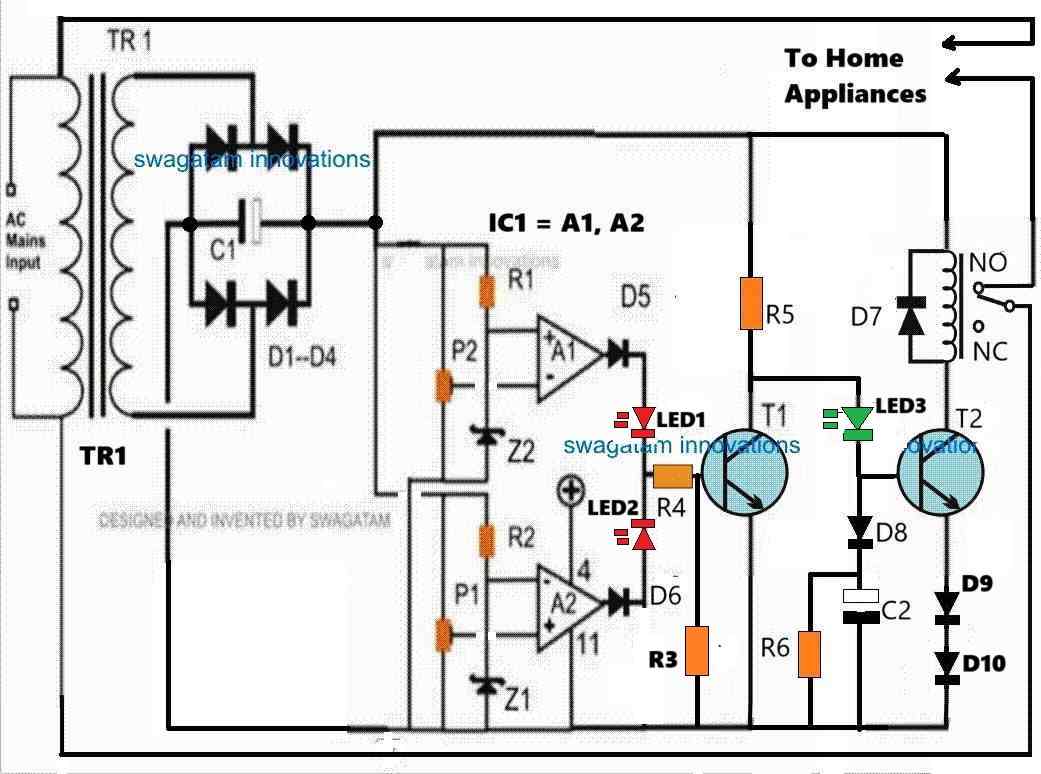
Take a variable DC power supply with a maximum range of 24V DC.
Disconnect the transformer stage from the circuit and hook up the variable power supply to the op amp circuit.
Keep R5 end disconnected from the positive supply.
In the circuit, P1 determines the high voltage cut-off point, and the P2 preset determines the low voltage cut-off point.
Initially, keep the P1 wiper arm of the preset fully towards ground. Keep the wiper arm of the P2 preset fully towards the positive supply side.
Adjust the power supply to around 16V and switch it ON, you might notice the following things.
You will find LED1, LED2, LED3 all turned OFF.
Now, adjust the variable power supply output to 20V, and carefully adjust the P1 preset until the LED2 just illuminates. To confirm the result try reducing the 20V to 19V, you should find the LED2 shutting off, this would confirm your high voltage cut-off point is fixed.
Now, reduce the variable power supply voltage to 14V, and carefully adjust the P2 preset until LED1 just illuminates. To confirm the results, try increasing the 14V to 15V, you should find the LED1 immediately shutting off. This would confirm your low voltage cut-off is fixed.
The above procedures complete your high voltage and low voltage settings of the presets.
Turn off the variable power supply and proceed to the following step.
Setting up the Switch ON Delay Function
Now, let's see how the delay-ON surge protection can be setup.
Recall we had disconnected the R5 upper end with the positive supply, restore this connection back with the positive supply.
Keep the R4 end disconnected from the LED junction.
Now, adjust the variable power supply to 16V and switch it ON.
You will find the green LED quickly coming ON, but the relay should not switch ON immediately. After a few seconds the relay should also switch ON.
If you are able to witness the above operation, will prove that your delay-ON surge protection is working perfectly, as intended.
To further confirm, you can turn off the power supply, wait for a few seconds and turn it ON again. You should be able to notice an identical delay ON function of the relay happening.
This confirms the delay ON function of the home protector circuit, and this setup is complete.
Next, join the R4 end back with the LED1/LED2 junction, and turn ON the power supply (adjusted with 16V DC output).
You should find LED1, LED2 turned OFF and LED3 turned ON immediately, and the relay turning ON after a few seconds.
So far so good.
Now, try increasing the power supply voltage to 20V, which should instantly turn ON LED2, and turn OFF LED3 and the relay (at N/C position).
Next, start decreasing the voltage, as you go below 19V, the LED2 must instantly shut off, turning ON LED3 and the relay (at N/O position). The relay should turn ON with some delay, as per the previous setting.
As you lower the voltage, keep going until it reaches around 14V. At this point the LED1 should instantly turn ON, turning off LED3 and the relay (back to N/C point).
Repeat the process up/down until the relevant outcomes are thoroughly confirmed as explained in the above setting up procedures.
Once you are convinced, remove the variable power supply and configure the transformer DC power supply with the circuit and switch it ON.
Assuming the input AC is normal during this period, the red LEDs should remain turned OFF, and the green LED must turn ON. The relay should turn ON after some delay.
That's it, the setting up procedure of the home protector circuit is complete and is ready for the final integration with your AC mains, for implementing the intended high/low AC voltage cut-offs and the switch ON surge protections.
Home Protector Circuit with Extended Delay ON Surge Protection
In case the AC mains power outages are frequent and inconsistent in your area, you may want to have the delay ON surge protection time to be longer.
As suggested and confirmed by Mr. Ali who is a dedicated reader of this blog, the following home protector design can be used for implementing a much longer delay ON time surge protection.
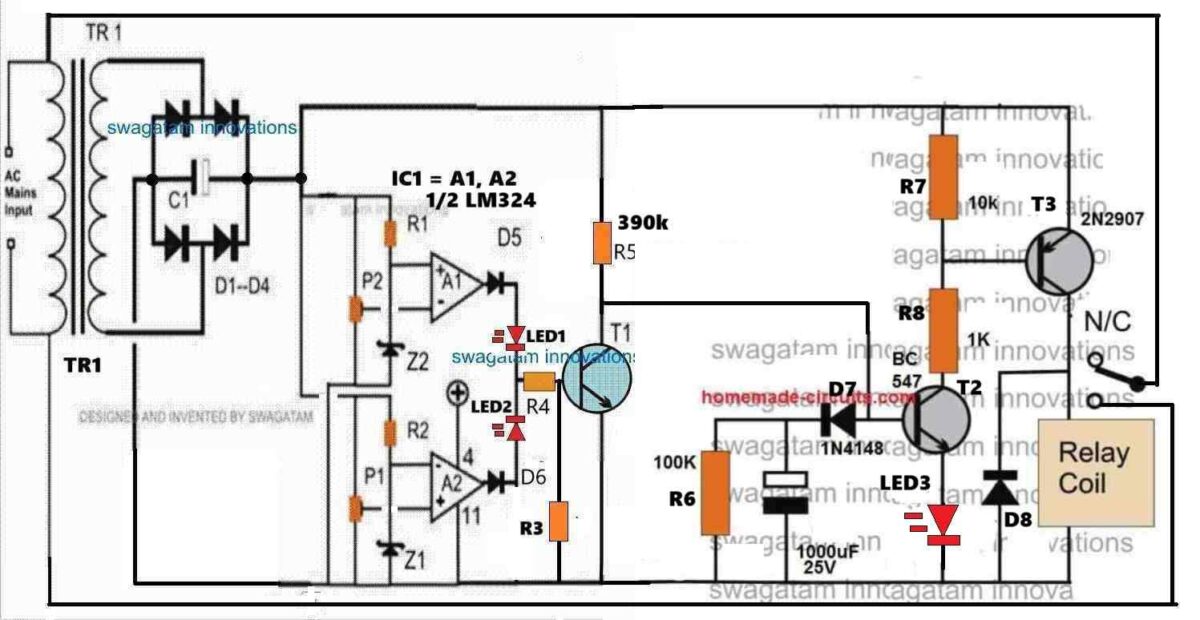
Video Test Results
The following video shows the basic testing procedure of the above explained home protector circuit. The video was contributed by Mr. Ali.
A heartfelt thanks to Mr. Ali for his hard work. His testing and video contribution to homemade-circuits.com are much appreciated.
Conclusion
The above explained mains AC home protector circuit can be built and installed in homes for getting a full fledged protection from fluctuating high and low voltage situations and from sudden voltage in rush during power outages. If you have any further questions and doubts regarding the above concept, feel absolutely free to contact me through the below given comment box.
greetings..!!!
dear Swagatham,
Thanks alot for such professional stabiliser circuit as home protector.I have some modifications. first of centre of high low preset fix an 22mfd capacitor to ground both high and low preset moreover the base of BD140 to ground was 1k but change that value to 2k2 to increase the life span of led.And connect 100mfd capacitor across relay point.Then this circuit will work extraordinary results. (This is the circuit with transformer and BD140 and 7812)my humble request is make all this circuit together named under home protector headline .so easy to try one by one.Anyway thanks alot such amazing circuit.
Thank you so much Dr.Sison, I greatly appreciate your kind feedback and the improvements you have suggested.
I hope the readers will take note of these suggestions and do the procedures accordingly.
When I have time I will surely consider updating all the diagrams in the comments section in the above article….
Hi.
First of all, thank you for sharing such wonderful information.
The current load of the house is sometimes 60 amps. Can the relay cut off this load in the circuit you share?Is the load capacity that the relay can handle in closed contact greater than in open contact?
Hi, you are most welcome….yes, the relay can handle this much load, if the relay is rated at 100 amps…
The relay is handling the full load when it is closed in N/O position…
sir can i use 50k instead of 22k? also 22uf400v is blast. can i use 100uf 420volt, and imstead if 105j can i use same 0.33uf? 105j 400volt is giving 131volts, mqy be due to this its happen…..
Yes, you can use 50k instead of 22k preset.
2uF/400V shouldn’t have blasted because the maximum rectified output DC from a 230C AC is 310V only, which is less than its 400V rating.
Anyway, you can use 100uF/420V.
105 cannot give 131V, it should produce 310V at the 220k upper end, assuming the input is 220V AC. You can try 0.33uF and check whether it gives 310V DC at the 220k upper end or not.
And, the P1, P2 must be preferably replaced with 100k presets to avoid voltage drop at the 220k/50k junction, so if possible use 100k presets for P1 and P2.
sir i assembled all components as your diagram, delay time is working, but unable to check low and high volt without variac, but i am getting 22uf 400volt capister is heating.its connected with 105j 400volt capister.
Ghulam, Please check the following updated diagram: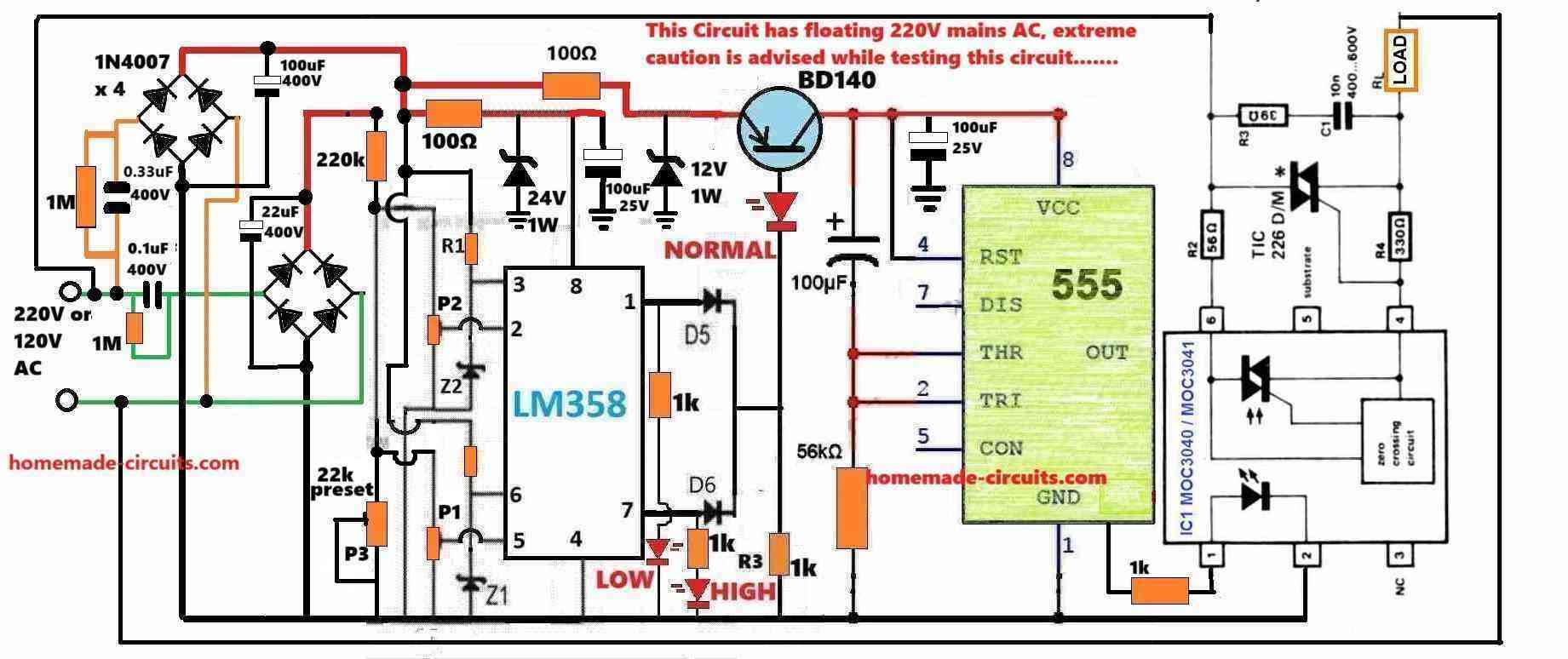
" rel="ugc">
Here, I have replaced the 10k preset associated with the 220k resistor with a 22k preset which can be used to adjust and set the high/low voltage thresholds.
Also in this diagram you can see that junction of 220k/22k preset is connected only to the presets P1 and P2 and NOT to the opamp zener diode resistors.
The zener diode resistors are directly connected to the other separate positive line.
In this way the 220k/22k(preset) junction sensing voltage will not get affected by any external elements and will provide the correct sensing voltage to the opamp.
How to setup
Initially keep the 22k preset wiper to ground level.
Suppose the normal input is 220V or 230V AC, now adjust the 22k preset until the junction of 220k/22k becomes around 14V.
So now 14V corresponds to 220V AC input.
With the above information in hand we want to calculate the high/low thresholds at the 220k/22k junction.
Let’s say we want the high cut-off at 270V and low cut off at 180V, we can find the equivalent DC at the junction of 220k/22k using the following calculations:
High level cut-off DC threshold
220/270 = 14/H
H = 17V
So in this example 17V corresponds to high equivalent at which the opamp must cut-off and produce a high at its pin#7 output.
Low level cut-off
220/180 = 14/L
L = 11.5V
So in this example 11.5V corresponds to low DC equivalent at which the opamp must cut-off and produce a high at its pin#1 output.
Using the above data, you can now set the P1 and P2 presets for fixing the opamp low/high cut-off points.
Once done, you can confirm whether or not the opamp is responding to the cut-offs, by moving the 22k preset up/down and by checking whether or not the opamp output HIGH/LOW LEDs are correctly switching ON/OFF at the relevant DC cut-off thresholds.
The 105/400V capacitor corresponds to 1uF/400V which looks unnecessarily high value, you can try 0.47uF/400V instead. However if you don’t have a 0.47uF you can carry on with the existing 105.
sir this is for confirmation. i used 105j 400v with 22uf 400v, and 334j 400v with 100uf 420volt, at 105j i am getting 131 volts, 100uf 420volt at positive connected 100ohm and connect 24 volt zener with 100uf 25volt, getting 24.2 volts, then i connected 12 volt zener, without 100uf 25 volts. then i am getting at 24 volts zener 13.2, and 12 volt zener getting 12.2volts,
is it ok? with 12volt zener need to connect 100uf 25 volt or no need?
thank you sir, i will update you once its done, sir how we can set high and low voltage in this version?
No problem Ghulam!
Ideally, to set the low/high cut-offs in this circuit you will need a Variac, a fan regulator cannot be used.
Alternatively, you can replace the 10k resistor associated with the 220k resistor with a 10k preset, then adjust this preset to get the desired low/high thresholds at the JUNCTION of the 220k/10kpreset, and then adjust the P1 and P2 accordingly to set the high low cut-off points. Be extremely careful, because the circuit is not isolated from 220V mains…
sir then how we can use two bridge, while i am using SSR with bt136, as my assembled, with two 0.33uf 400v bridge and 22uf 400v positve i connected with 100ohm, and op amp positive given from 24 zenor. and ground to opamp ground. then again 100ohm conected with 22uf 400v with 12volt zenor. this point connected with bd140 emiter. as this setup i used fan regulater and low cut is working. but unable to check high voltage because fan regulater given 235 volt max,
in this situation if i use 220k and 10k then i am unabled to setup low and high voltage.
Hello Ghulam,
I will provide you the diagram using an SSR. I will let you know once it is done.
Ok, here’s the updated design yo can try: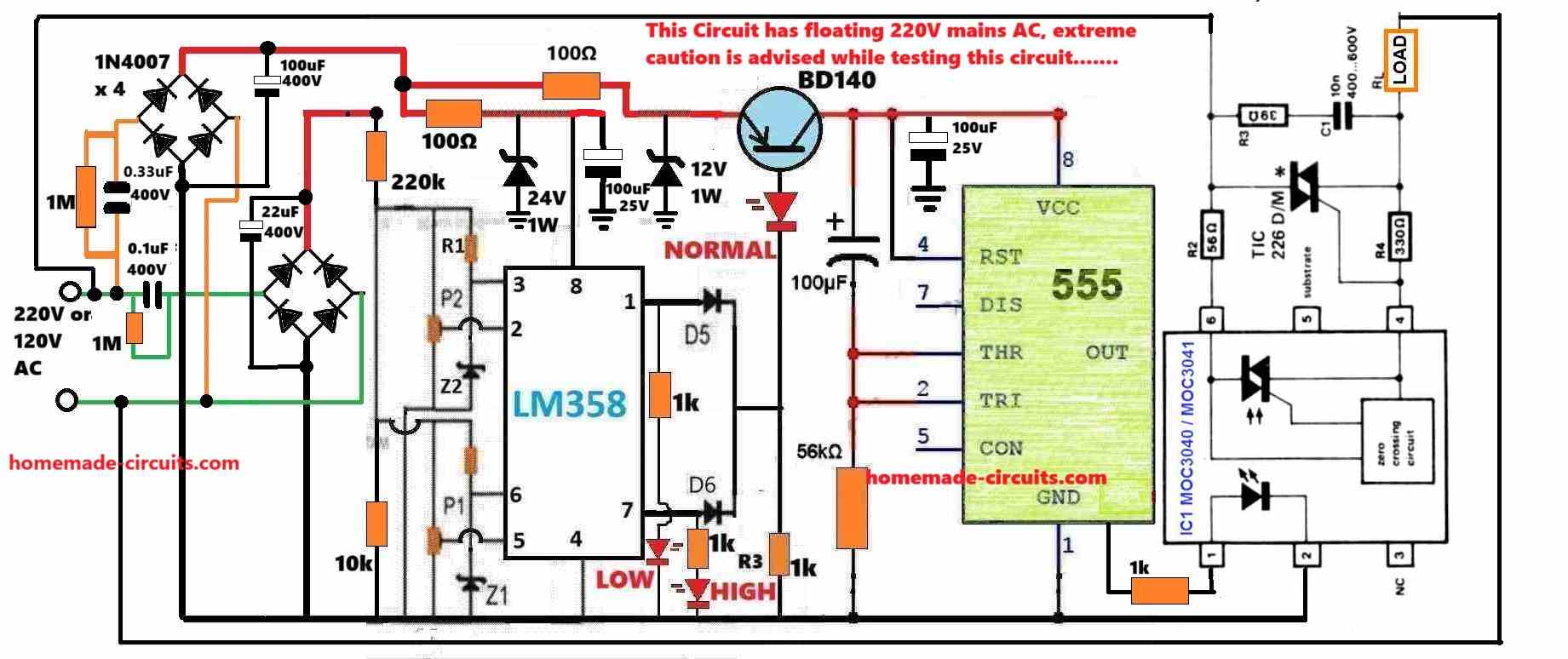
" rel="ugc">
hello sir, sir i removed 220k and 10k and directly connected positive and ground. its working perfect with high volt cut, but at low volt, normal led is dim while voltage low, not properly off, and if i used 1k resister from ic 555 pin 3 to moc3021 pin 1, voltage showing after 1k at moc3021 pin 1, 1.1volt, if i removed 1k then voltage showing 11.7 volt, but i think in this situation moc3021 not in safe stage, what i do for safety of moc3021?
also guide me 220k and 10k removed is ok or its harmfull for circut?
Ghulam, the 220k/10k can be removed only if the circuit is powered by a transformer/bridge. If you are using capacitive power supply then the 220k/10k resistive divider is a must for dropping the detection voltage to the op amps, if you remove it, the opamp will burn.
The 1.1V after the 1k is correct because the internal LED of the MOC3021 is dropping the voltage to the forward voltage level of the internal LED. If you remove the 1k, the MOC3021 internal LED may burn.
The “NORMAL” LED will shut off only if the emitter voltage of the BD140 is at least 3V lower than the voltage supplied to the Vcc pin of the opamp.
hi sir, hope all is going well. sir i am sorry for trouble you. but i want to make this project succes. i am facing issue with cuttoff stage, i used two 0.33uf 400 volt in parallel, and 22uf 400 volt capister, getting 17volt, i disconnect from bridge, and connected variable supply set at 20volt for high cut, moving vr for high cut, its just normal led glows, same thing at low (14volt)voltage, i connected positive of both VR joint of 220k and 10k.where ic pin 6 and 3 are connected with 10 k fixed resister, as per diagram. as you suggest i used ssr for load.
other end its working with transformer version which you sent with 7812. plz make it easy for me…..
i am stuck with this project….i used single bridge with two 0.33uf 400volt.
Hi Ghulam, If you are using a variable DC 20V power supply for setting the preset, then it cannot be connected to the 220k/10k resistor divider because that divider is for sensing 310V DC input from the 0.33uF/400V capacitor.
And the voltage across the 22uF/400V must be 310V, if your input supply is 220V AC, it cannot be 17V.
That is why I think we need a separate capacitor bridge supply for the 220k/10k sensing input, and a separate capacitor/bridge for the BD140, 555 and the SSR stages.
hi sir,
sir problem is in the voltage, i checked as you guide, delay timer is working, at 555 ic voltage is 5.7. and at the bridge of 0.33uf voltage is 6.8, i tried with 105j instead of 0.33uf, voltage same, but if i used 225j instead of 105, 100ohm resistance burn which is connected with positive and 24v zenor, due to low voltage cut off also not working…..
OK, good, so that means delay is working. With 205 capacitor the 100ohm will certainly burn or there will unnecessary heat dissipation, so I think you can try connecting another 0.33uF parallel with the existing 0.33uF capacitor to make the 555 DC supply perfect, or a 0.47uF/400V will also do.
Now please check the high low cut-off by adjusting the P1, P2 presets, and check whether the High, Low, and Normal LEDs are switching correctly or not.
Another thing is that, if you use a Triac instead of a Relay for switching the output load then a single bridge/capacitor will be sufficient, no need of two separate bridge power supply configurations. Also the 2N2222 can be avoided if a triac is used.
Triac will also make the whole unit perfectly sold-state and very compact.
no sir delay time is not working, relay direct on once we give power. bcause we are giving positive through bridge.
sir what is the purpose of 2 bridges, and also why can we use 1 bridge with 225j 400v and 10uf 400volt and 24 volt zenor, also with pnp collecter can we connect 12 volt zenor for delay timer, is it possible?
Please connect an LED in series with the 2N2222 base and check whether the LED is glowing or not, if yes, try short circuiting the base/emitter of 2N2222 and check whether the relay is switching OFF or not this will prove 2N2222 is burned or is good. and also check the voltage across the 555 IC.
Relay requires high current whereas IC circuits require low current, that is why " rel="ugc">separate bridge supplies are used.
If you use single high current capacitor bridge then the IC or the zener might burn or the series resistors might heat up and burn.
Afterwards you can try single bridge supply….
hi sir, sir i assembled transformerless version,i didnot get 2uf 400volt, instead of this i used 225j 400volt and 0.33uf400volt instead of this i used 334j 400volt. i used 10uf 400volt with both bridge, which is connected with 334j 400 volt bridge i am getting 15.4 volt, and another bridge which is connected with 225j 400volt, i am getting 131 volt, once i connected bridge positive to relay positive with in4007 diode as u show in the diagram, 1k resister which is connected with relay led, that is burned. may be due to high voltage(131volt),and the other end at 12volt zenor voltage getting 12 volt, but at 24volt zenor voltage is 15.4 almost.
plz guide me, weather componnets are ok or not?
Hi Ghulam, With reference " rel="ugc">to this diagram, your part vaalues look OK to me.
Is the relay operating? If yes, then try decreasing the 225 value to 105 or 1uF/400V, and check again if the relay is operating correctly or not.
Is the delay feature working?
If yes, then your circuit working OK.
But 24V should not drop to 15V. It might be happening because the 0.33uF capacitor current output is not sufficient to drive the op-amp IC and the BD140/555 stages together.
Try adding another 0.33uF/400V in parallel with the existing 0.33uf/400V capacitor and check whether it increases the voltage across the 24V zener diode or not?
thank you sir
thank you sir, once i completed i will update you, sir with both bridge rectifier filter capister is required or not? in diagram not mentioned filter capister.
Hi Ghulam,
I am sorry, I forgot to show the capacitors across the bridge rectifiers.
For both the bridge rectifiers you can connect 100uF/400V capacitors, across their positive and negative terminals. If 100uF/400V is not available you can use any lower uF value also, but the voltage must be 400V.
Additionally, please connect a 1000uF/50V across the relay coil.
And a 100uF/50V across the 24v zener and 12V zener each.
ok si, thank you, i will update you soon
ok, no problem.
sir over and under voltage section is easy for me, plz give me transformerless power suply version. i am sorry for all troubles which i create for you. and also thanks for your passion.
Hi Ghulam, Ok, i will do the transformerless version soon, and let you know once it is done…
Hi Ghulam, I have designed the transformerless version, as given in the following link: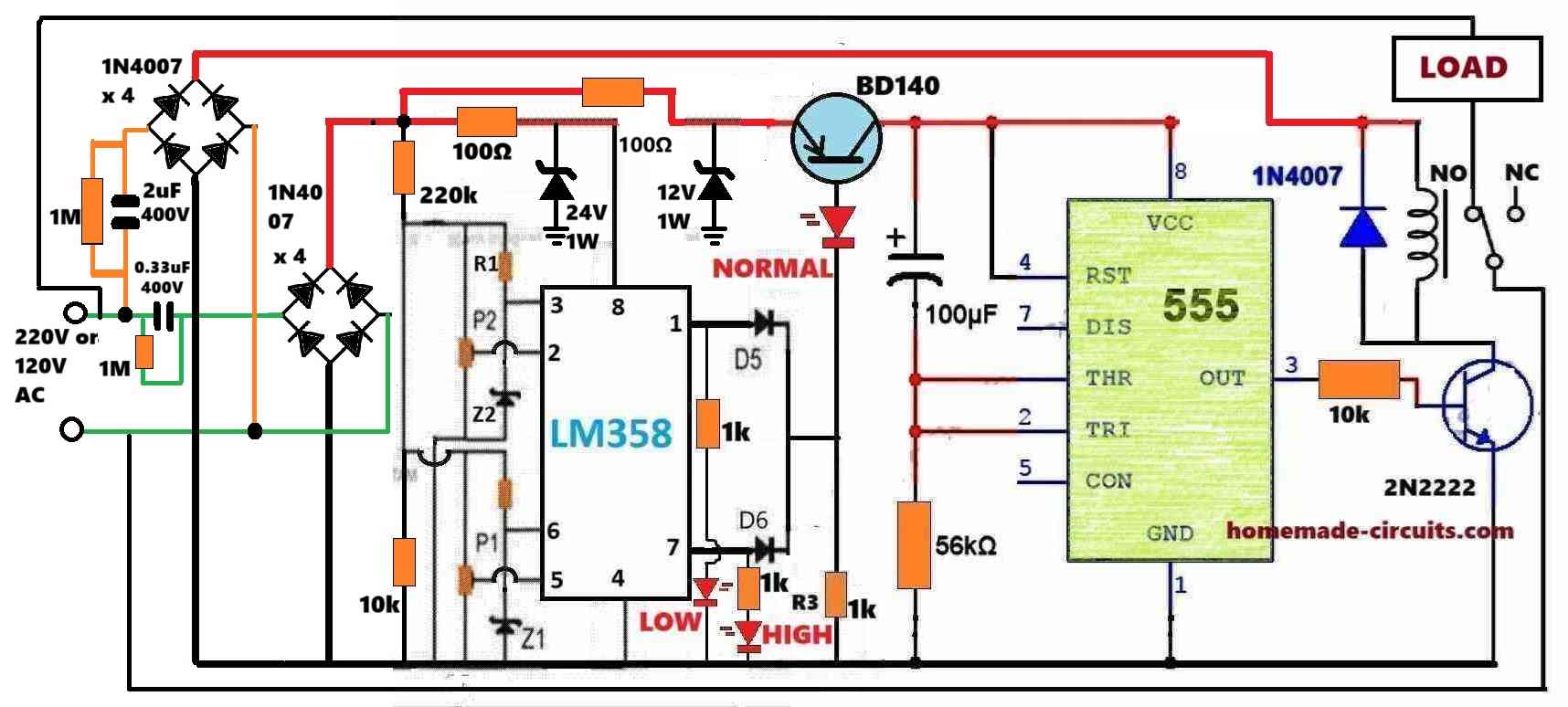
" rel="ugc">
Please build it very carefully, and don’t make any mistakes.
Keep a watch on the 2N2222 relay driver transistor, and check if it blows or not, mostly it won’t.
Please remember that the entire circuit would be floating with mains 220V AC, so be extremely careful while testing the circuit in powered ON condition.
sir i connect led with base of 2n2222, led glow but once i short with emiter lee is off not relay, then i change 2n2222, i found 2n2222 is heating…..also delay time not working.
Ghulam, Please keep the " rel="ugc">relay disconnected from the 2N2222 temporarily, and keep the 2N2222 also disconnected from the IC 555 pin#3
Now connect an LED between pin#3 and ground through a 1k resistor.
Now check the delay effect on this LED.
Please check the voltage across the 555 IC (+) and ground terminals.
Keep the meter connected across the 555 supply pins and check the response when you first switch ON power.
Also make sure the “NORMAL” LED is ON.
Ghulam, please try to reply under the correct thread, or create a new thread, otherwise the comment sequence breaks and becomes difficult to understand..
sir i disconnected opto copler, and bt169 from relay transister, then with led positive connected 1k resister and connect with capister positive which is connected with bridge in4148, and led negative with negitive, then supply on ,after delay relay is on, then i connected mobile charger as a load, its showing 0.2, then as load i used 40watt soldering iron, voltage same 0.2,
is there any other way to control current? like with 555 ic or lm358? may be this i am not understanding. its humble request plz test this circut with you and provide me diagram with final compnents. then i will make all connections and check. plz its request
Hi Ghulam,
You must understand the working, then it will be easier for you to troubleshoot it.
It is basic Ohms law, that when current passes through a resistor, it develops a proportionate amount of voltage across it.
Please disconnect the 1N4148 bridge across the Rx resistor and measure the voltage directly across the RX resistor with an AC Voltmeter.
If still there’s no change in voltage with respect to load, then I cannot help, you will have to cancel the over load feature and stay only with the over/under voltage, and with transfomerless version.
For the transformerless version also, you must first understand how the circuit works and only then try it.
hi sir, i checked voltage, its showing 0.2, i disconnect opto copler and bt169 from relay transister base, at in4148 bridge 100uf already connected, led connected with 1k resister, its showing 0.2, i dont know its checked correctly or not, plz guide me
otherwise plz provide me transformerless supply version with over under voltage protection plz
Hi Ghulam, how much load did you connect with the relay N/O contacts. Please check the voltage by increasing the load, as the load increases the voltage must also increase proportionately.
sir for testing voltage at in4148 100uf caposter should be connected with in4148 bridge rectifier or not?opt coupler completly need to disconnect from bridge?
Yes, 100uF must be connected across the RX bridge rectifier and the opto-coupler completely disconnected.
sir i tried with 0.47 ohm 5 watt, as load i checked with water moter, its taking almost 9amp normally, when i start moter, relay flicker and cutt off, when moter off relay auto on at same time,then i removed bt169 from base of relay transister(bc547) to make sure relay can run moter or not, but in4148 burned which is connected with RX, as i am using 30 amp relay……its relay issue or some where else?
Hi Ghulam,
You must first check the voltage across the 1N4148 diode by connecting an LED and disconnecting the opto-coupler and the SCR.
You must go step by step.
1N4148 bridge cannot burn unless its output is short circuited, so I am not sure how your 1N4148 bridge rectifier burned?
A motor will draw high current initially, and then settle down to normal current, so at start up the motor current can be very high.
Please check using only bridge rectifier and LED (use series 1k resistor instead of 100 ohm for better safety).
sir i am using quarter watt RX. i have 0.47 ohm 5 watt resister, can i check with that?
Yes, you can use that resistor…but with a 0.47ohm resistor you may need above 1000 watt load to test.
0.47 = 2.5 / I
I = 2.5 / 0.47 = 5 ampere
5 * 220V = 1100 watts
thank you sir, actually sir RX value is confusing, first i was using 3.3ohm, it was cuttoff on mobile charger, and 100watt bulb, but 40 watt and 60 watt was working, then i changed RX 3.3 to 2.2 ohm, i connect load combine iron, 100 watt bulb, 400watt drill, all load works together. then again i changed 3.3. now also not cutt off. thats why i am confusing, if you can provide me exact value of RX for 25 amp, and guide me for load, at how much load its cutt off, then i will check and add feature..plz
Ghulam, what is the wattage of the resistor you are using?
Make sure to use a high watt resistors such as 2 watt or 5 watt.
Only by measuring the voltage across the bridge rectifier will tell you whether the resistor/bridge configuration is correct or not.
Or disconnect the bridge from the opto-coupler and connect an LED/resistor across the bridge as suggested earlier.
sir i did but led not glow, yes i am using 100 ohms resister with led. sir may be this is high level. may be i cant make, sir is it possible provide me transformerless power supply with only over and under voltage plz due to my less knwlodge i am disturbing you much, i am sorry plz
Ok, no problem, if you are finding the overload feature difficult to implement, you can leave it.
I will try to design the transformerless version soon, and let you know once it is done…
hi sir, i connect led with in4148 bridge rectifier, but led not glow, i found RX 2.2 ohm resister i tried. mobile charger, 100 watt bulb, iron working combine, not cutt off, then again i connect 3.3ohm as RX now with 3.3 ohm also not cutt off even with mobile charger also,
i am sorry sir but i am confused. now i dont know scr have an issue or other component, can you guide me how i can check…..plz
Hi Ghulam,
The idea is very basic.
The RX resistor develops a voltage across itself which is proportionate to the load current, as the load current increases the voltage across the RX resistor also increases proportionately.
Please disconnect the bridge rectifier output from the opto-coupler and check the LED glow again.
I hope you have connected a series 100 ohm resistor with the LED.
If it is a 3V LED, it will require around 2.5V to start glowing, so the minimum RX value should be:
RX = 2.5 / load current
hi sir, i have ome confussion, i used 3.3ohms as RX, 60watt solder iron is working, but when i comnect mobile charger as a load, relay goes off, 100watt heat gun also cutt off, what is the reason? is there any problem with circut? i am waiting for transformerless power supply version. a lot of thanks
Hi Ghulam,
You connected the mobile charger with 60 watt load connected or without it?
Increase the 1uF value at the SCR gate to 10uF or 22uF and check the response.
sir i tried separately, once i connected 60watt soldering iron, relay not cut off, then remove soldering iron and connect mobile charger, its cut off, i changed 1 uf to 10uf, gate to ground, but same response, sir plz suggest me RX value for 25 amp, i am sorry but didn’t understand in that formula 2.4……plz don’t mind,
Ok, please connect a 100uF across the positive and negative of the RX bridge rectifier (1N4148 bridge), and let me know the response.
sir may be some thing wrong from my side, thats why i want to update, if first i connect the mobile charger, and then switch on the power supply of circut, then charger working but relay give 2 sounds of click, if i remove charger and connect again its cutt off, plz guide me where is the problem plz sir if you dont mind is it possible to send you vedio for this, becuase once its cutt of relay led some time blink,may be its due to scr?bt169
Ghulam, Please disconnect the BT169 SCR from the relay transistor base.
Connect a 100uF across the 1N4148 bridge rectifier.
Now, connect a 100 watt load and measure the voltage across the above 100uF.
Then reduce the load to 60 watt and measure again.
Then connect the mobile charger and measure again.
Be very careful since 220V mains is involved.
Which relay LED blinks? We have only 3 LEDs, High, Low and Normal?
Please always provide full details so that it becomes easy to understand.
i disconnect bt169 from relay transister base, sir 100uf is already connected with in4148 bridge rectifier, as per diagram, with that same 100uf 50volt i checked with 100watt heat gun, on capister shows 0.6 voltage then i connected 60 watt bulb voltage is 0.9
with 60watt soldering iron voltage 0.6,
with mobile charger voltage 0.6, load is on with relay, i am sorry if i am wrong, also i am talking about relay led, i connected led with relay, for status of relay weather on or off,….again i am sorry for trouble plz
Hi Ghulam,
The " rel="ugc">voltage across the Rx resistor must increase proportionately as the load is increased.
If the voltage across the Rx resistor shows 0.6V for 100 watt load then it cannot be 0.9V for a 60 watt load.
Also mobile charger wattage is so less, hardly 5 watt, so how can it generate 0.6V same as 60 watt load.
Something is not right with your measurements.
Do you have an analogue meter? Meter with needle?
Please confirm with an analogue meter.
hi sir, i am sorry sir, i dont jave analog e multimeter,, can we check any other way plz, sorry again pz
Hi Ghulam, please connect an LED directly across the 1N4148 bridge positive and negative through a 100 ohm series resistor and check the glow on the LED.
Hi
How to discharge c2 instantly delay not happening cause c2 remains charged and discharge very slowly after full discharge delay happened as usual
Hi
I make the Mr. Ali circuit with extended delay but
Delay happening only on startup not if we cut switch on off Or intermediate I tried r5 100 k and 200k with both resistor delay time was 15sec and 28sec respectively but no delay time if we just switch off and on in 1 sec but after 5 sec I get delay around 5 sec and after wait around 20 sec. I got 15 sec delay pls guide
Thanks for trying the circuit, I will try to solve the problem.
You are right, it is because the 1000uF capacitor is not discharging quickly via R6, and we cannot make R6 too small, otherwise T2 won’t conduct.
You can replace the the R6 with a PNP transistor as shown in the following diagram and see if it helps to quickly discharge the 1000uF capacitor or not. For the zener diode you can take a 3V zener.
" rel="ugc">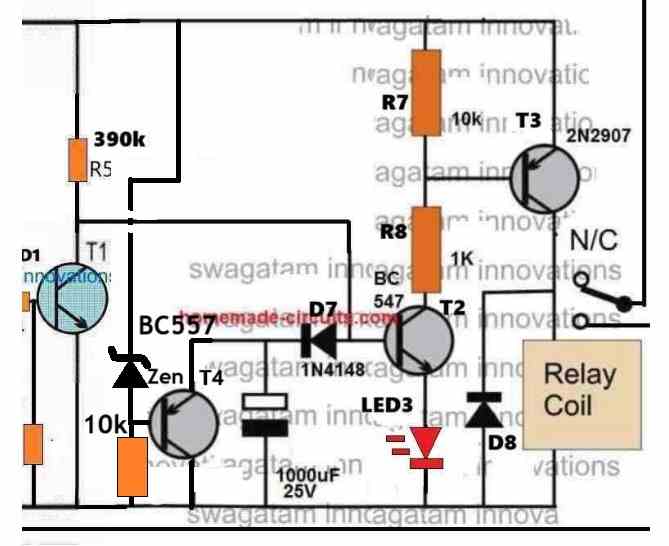
Hi
Sir i tried by replacing r6 with bc557 but no success it’s working same as it’s working with r6
Hi,
It should work according to me.
As soon as you switch OFF power, the positive supply through the zener diode to the BC557 base is cut off which allows the BC557 to conduct via the 10k resistor, which shorts the 1000uF capacitor via collector/emitter. You can confirm the BC557 conduction using a DMM in the DC volt range, and by connecting its probes across the collector/emitter.
While the circuit is powered the meter should display the existing voltage level across the 1000uF capacitor, and when power is switched OFF the voltage level must drop almost to zero.
Sir
At powered circuit voltage across capacitor is 1v and at power off it’s around 0.44v but relay contacts but if we short c2 manually delay happening
Hi
By using around 5.5 k r6 resistance it worked and delay happening if we cut switch for 1 sec and less
Thanks
Thank you Jas, for the update.
If reducing R6 to 5.5k solves the issue, then you can use it in your circuit.
dear sir….thanks for giving us a very important project. yoi always provide a helpfull circits, and your passion to guide awesome.
sir as usual i need your support. as you know i am not much famlier with ics diagrams sir plz provide me diagram like you help me in timmer circut cd4060 and cd4017 with ic/transisters pinout. plz
No problem Ghulam, I will surely try to help.
Please tell me which diagram you are not able to understand, I will try to figure it out for you.
sir that ic lm358 section a1 and a2, pots connectivity…this section diagram i m not understaing. plz make it with ic and pot pins plz
Ghulam, It is actually very easy to replace the LM324 opamps with LM358 opamps. Please see LM358 diagram below, just replace the two opamps pinouts in the diagram with the pinout of the LM358, Next connect pin4 to ground and pin8 to positive: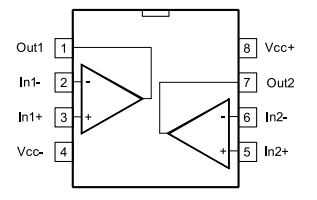
" rel="ugc">
Let me know if you have any difficulties.
Hi sir,
Hope all is going well, due to not founding some components of this project its delayed. Sir can we use 5 volt zenor instead of 4.7 volt? Also can we add Variable supply in this project for future testing,
At which points we have to connect AC volt meter, or dc volt meter?
Hi Ghulam,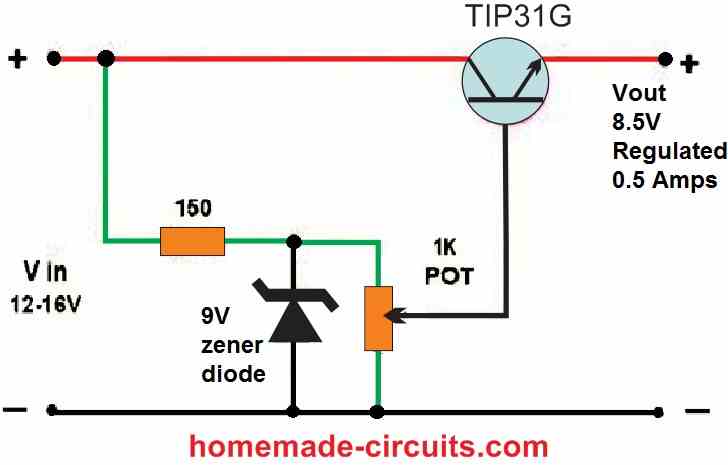
You can use any zener diode between 3V and 6V.
To make the DC variable you can add the following circuit stage between the bridge rectifier and the rest of the circuit:
" rel="ugc">
A DC voltmeter can be connected right across the supply terminal of the op amp IC.
Thanks for reply, i started work on this, as soon as possible i completed i will update you. A LOT OF THANKS
No problem Ghulam, all the best to you.
thank you very much sir, now i can try to make easly. a lot of thanks. appriciated your support.
You are welcome Ghulam.
sir actully i am umable to understand symbol of ic, i am requesting that plz provide me full project diagram as like timer project, with cd4060, and also you guide me before changeover circut with cd4017 and cd4060. with actuall shape of ic lm358, with pins conectivity. hope you got my point. i m sorry to disturb you.
Hi Ghulam,
You can check the updated image in the following link, using LM358:
" rel="ugc">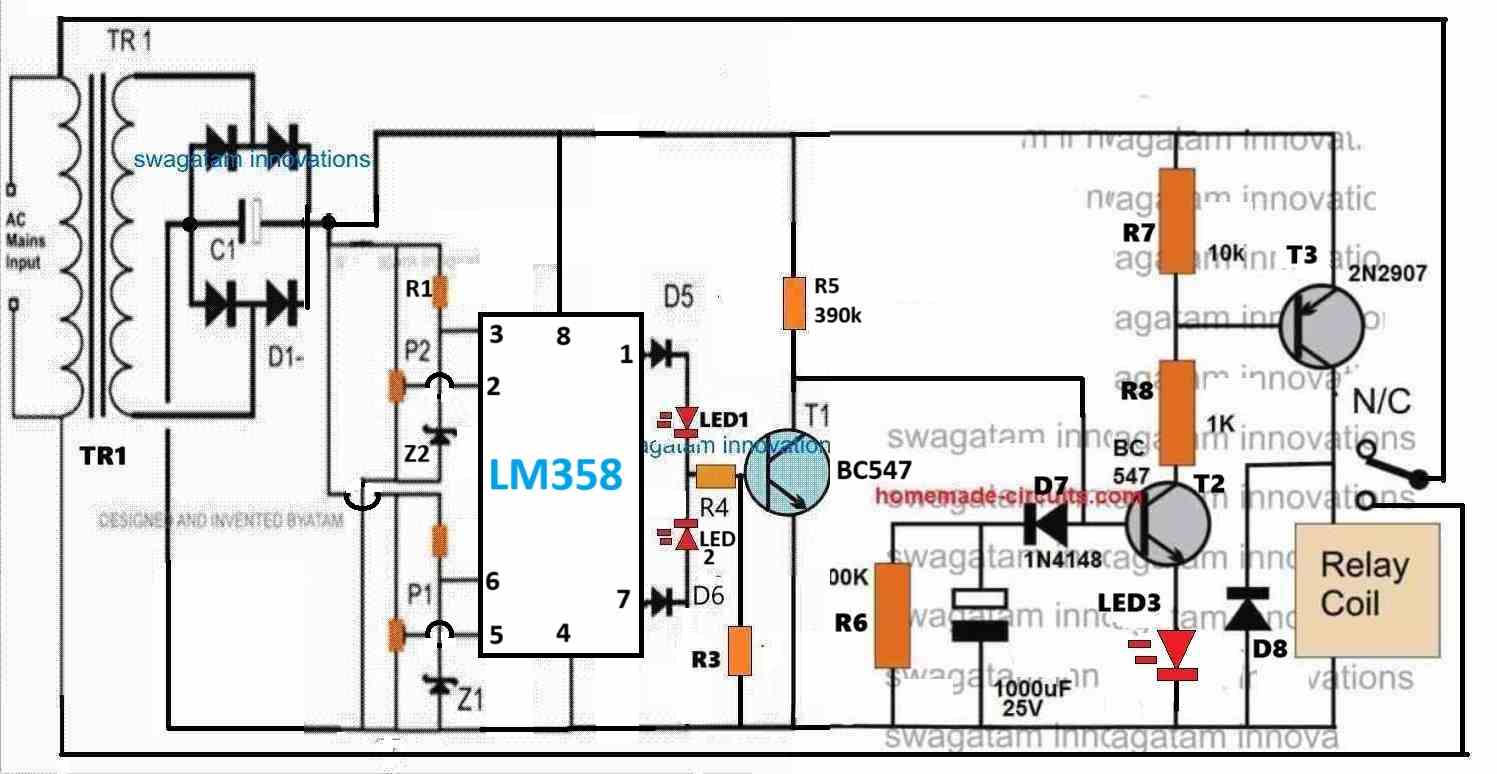
hi sir,
hope all is going well. sir i have two questions, can we replace transister 2n2907 with bc557? or any other pnp? sir can we add current protection? like we are using 30amp relay, if load more than 30 amp load cutoff. or we can set 10 or 15 amp like that. plz add this featuer also plz. i am going to make this project, but waiting for update version plz. plz provide me diagram
thanks
Hi Ghulam,
For a 30 amp relay, the coil resistance could be 100 ohms or lower, which a Bc557 might not be able to handle. Therefore, you must use a 2n2907, or 8550 or maybe BD140 transistor as the relay driver.
I will surely help you to add an over-current protection to the circuit, but first please try the basic setup explained in the above article.
If you succeed with it then i will show you to integrate an over-current stage with the circuit.
If you go step-wise it will be easier for you to troubleshoot, in case something goes wrong.
ok sir, i will update you soon. a lot of thanks
Sure, all the best to you.
Hi sir,
Sir i tried many times on zero board and bread board, in start no one leds glow, after adjust the volts i moved vr but no thing happen, on ic i am getting voltage, but circut not funcioning, with both VR nothing happen, max 20v and low 14volts, if yoi dont mind plz guide me how i can check, i read full article and tried to follow the setps, i am using lm358 as per your diagram, which you sent me. Plz check and guide me step by step, how i can check…plz
Hi Ghulam,
Referring to the following diagram, did you connect the pin#8 and pin#4 correctly to the supply terminals?
" rel="ugc">
Additionally you can check the following:
Check the voltage across pin#8 and pin#4 and make sure the supply voltage is reaching these terminals.
Check the voltage across pin#3/ground, and pin#6/ground, confirm whether these pins are clamped at voltages corresponding the zener values.
Temporarily disconnect R4, T1 from the LEDs, and connect R3 directly between the LED junction and the ground.
Check LED polarity, make sure it is exactly as given in the diagram.
Still if the LEDs do not respond to the P1, P2 settings then your IC could be possibly faulty.
Please let me know how it goes.
Sir i tried as u guide, now cuttoff is functioning but third led not on, as you write set power on 16 v then third led immidiatly on. But not, plz guide me this step then i will move to delay time section plz led section 10k i connected to base of first bc547, and 4.7k base to ground. First bc547 emiter to ground and collecter to positive, then first bc547 collecter to 2nd bc547 base, 2nd bc547 emiter to led positive and negative to ground, 2nd bc547 base connected in4148 plain side, and black side to 22k, and 22k to ground, then collecter 1k and 10k in series to positive. I seted power on 16 volt, but third led not on, if i increase or decrease volts cuttoff working,
One thing more i want to tell you. While i connected power lower voltage led just blink,
Plz guide me
Hello Ghulam, which circuit have you built? Are you trying the following circuit:
" rel="ugc">
In this circuit the LED3 will illuminate only after the delay period is elapsed (relay switched ON) and only while LED1 and LED2 are switched OFF, meaning when the input voltage is within the normal range.
To stop LED1, LED2 blinking at thresholds you can add a 10uF/25V capacitor across pin2 and ground, and pin5 and ground.
Yes sir i am trying thia same circut, its mean i have to omplete first full circut, then check, i will update you…i will add capister as you guide for leds blinking.
No problem Ghulam, let me know if you have any further troubles.
Sir i tried and its working, i used for delay 100k to t1 collecter to positive, and 1000uf between d7 and r6 positive and ground, third les glow first slowly after some time relay on, bur if i switched off, then immediatly relay on……what i do for quickly discharge the capister?mr jas used 5.5k is it ok?or need to use pnp as per your diagram which you guide to mr jas
Thanks Ghulam, glad it is working now.
I think, as done by Mr. Jas you can try reducing R6 to 5.5k or 10k and check if that helps to switch ON the relay quickly enough.
Let me know if that works or not then I may suggest something other modification…
Ok sir i will try and update you, sir one thing more if we can add, for the power supply safety, because if voltage is high or low, then may be its effect on transformer. Can we add fuse or some thing else which can save transformer.if you suggest fuse then how many amp? I am sorry for too much questioning……
Hi Ghulam, Yes, you can definitely add a fuse at the 220V input side of the transformer. The fuse can be a 100 mA fuse.
Hi sir, Can we give power from variable supply with lm317 permenantl to circut?normal voltage set permanently, while we required setup for low and high voltage we can use, i have 12 0 12 800mah transformer, which is giving with 1000uf 25 volt cap max volt almost 35, LM358 can support or not? i want to use this for permanent. Is it possible?
Hi Ghulam, you can use LM317 variable supply only for testing the setting up the high/low cut off points, but not permanently, because the circuit cannot use a fixed supply from the LM317, it should be directly from the transformer bridge rectifier, so it can sense the corresponding high low from the mains AC.
You can use the 0-12V wires of the transformer which may produce upto 16V DC for the circuit.
The LM358 can tolerate upto 32V max.
First of all i want to say thanks for your kind aupport. Project is working now, i tried with 10k as R6 but what i faced capistor not charged fully, stop at 1volt, delay not happened, then i replace with 22k its works, but when we disconnect power and immidiatly connect again relay on with in sec..another issue i am facing that i connected 12-0 and getting 17 volts, once i attached circut volts drop to 14.4, due to that capister not charged properly, after 2 or 3 mints relay led on but dim, once i give power almost 15volts to circut its worked.
When i connected power only low voltage led blink once, i added 10uf 50 volt capister but its same, plz guide me what i have to changes, after that i will disturb you about current (Amp)protection i want to add this also in this circut
Thanks Ghulam for the detailed update.
The opamp LEDs must not blink after adding the capacitor at pin#2 and pin#5. I think the preset may not be adjusted correctly or the preset could be faulty. Please check again correctly.
Did you set the presets correctly with a variable power supply as explained in the above article?
Yes air same as article i tried, and once i move variable supply less than 14 cutoff working, same more than 20 volts, its works, and what about the power supply issue which i asked in previous email. Once i connected circut voltage drops, 17 to 14.4, and relay not on. Only third led after soe secends on but ldim…..
Please do one thing, remove the LED3 and replace it with a 1N4148 diode.
Now, connect the LED3 parallel to the relay coil with a 1k series resistor.
Now check the response.
Power supply voltage dropping from 17V to 14.4V looks normal to me, unless something is heating up.
Ok sir i will try and update you, when i connect the circut with power supply, transformer feeling heat. Without circut tempreture is notmal…i am using 30 amp relay, transformer is 230volt 50hz 12 0 12, i am connecting 12 0 only….
Hi Ghulam, please disconnect the relay and check whether the transformer is still heating up or not. Also check whether the IC is heating or not. If the transformer does heat up after removing the relay then it is fine. You can further confirm the results by checking how much current the relay is consuming.
Sir as per your instruction i removed 3rd led qnd connect in4148. After that when i connect the power supply relay direct on, delay timer not working, after that i dont know whats happen connect back to led but circut not working, power from r6 ground to 100k positve i am getting, but next no power. I think t2 faulty,
Sir is it possible plz make sure from side its humble request and provide me proper working circut plz. circut was working on 16volts but as my power supply i am getting 14.5, in this voltage circut not working……i am confused. Plz support me…..i think problem is between t2 to relay. May be nees to change resistance value or some thing else
Ghulam, the circuit is very straightforward and a perfectly working design. This has been already tested and verified by 3 readers, so i think something may be not correct in your configuration.
That’s why it is very important to first understand the function of each components and then build the circuit. If you understand the functioning of each components you will be able to complete the project quickly and successfully.
If LED3 at the emitter of the BC547 is working good for you then you can continue with that.
Also, you can temporarily separate the opamp stage and the delay timer stage and check them separately.
If you check the two stages separately it will be easier for you to troubleshoot
Also please check all the solder points correctly.
Let me know need any further help.
Hi sir, I am at the success stage; Circut is working. But I have some issues with the power supply while I am using the variable power supply, which is from the XL6019 boost-up converter. Circut is working perfectly, but only in seconds if the power connection back delay time is less than before voltage. Drops only while relay on, but with little difference, like power is 16 volts, on relay getting 15.5 volts almost, i guess may be my transformer faulty, i have used 800mah transformer, 12 0 12, using only 12 0, with 1000uf 25 volts, can you give me suggestion about power supply, can I increase 1000uf 25 volts to 50 volts? Or something else to make sure. But with variables, there is no issue except the capister discharging issue.
Sir, as I discussed earlier, I want to add an amp control as well. Plz provide me easy way to add plz……thanks
Hi Ghulam,
a boost converter may not be appropriate for testing, because boost converter output can drop when relay activates.
Please use a proper 24V transformer variable power, you can easily make one using an LM338 IC or any transistor regulator circuit
But the transformer should be 18v or 24V.
So you can do one thing, build a power supply using your existing 12-0-12V transformer, use the end wires to generate 24V AC and use it with this circuit, after rectification through a bridge and filter capacitor:
" rel="ugc">
In this circuit replace the 150 ohms with 1k, and the 9V zener with 20V zener or 24V zener.
Sorry I did not understand what you meant by “add an amp control”??
Sir this TIP31G or TIP31C, i am not familier with TIP31G, i have TIp 31C. Or is there any alternate plz? Amp control mean to say i want to add maximum ampere (current) control. Like we want when our load reachs to 10 or 20 amp load disconnect. With safery.
Hi Ghulam, any NPN transistor rated at 3 amp or 5 amp will work, so you can use BD139, any TIP31, TIP122, TIP41 etc etc.
I will show you how to add a current control in your circuit once you have successfully completed the present circuit.
Ok sir i will update you soon, and sir what about capistor discharge issue? If power connect back immidiatly then delay not working, if after 15 or 20 sec power connect then i guess after 15 or 20 sec relay comes on.plz guide me what i do for imidiatly discharge the capistor. Because some time light on off on off continusly. Its dangrous for appliances.
Ghulam, would you use an additional relay, it can be a small one. This relay contacts can be used to quickly discharge the delay capacitor….this method will be quick and 100% effective?
Sir Which relay now i am using 30amp 12volt relay……
Hello Ghulam, we can use another small 12V relay, whose N/C contacts can be used to quickly discharge the timing capacitor. That means there will be two relays, one 30 amp relay for the load, and another small 5 amp relay or any other small relay to discharge the capacitor.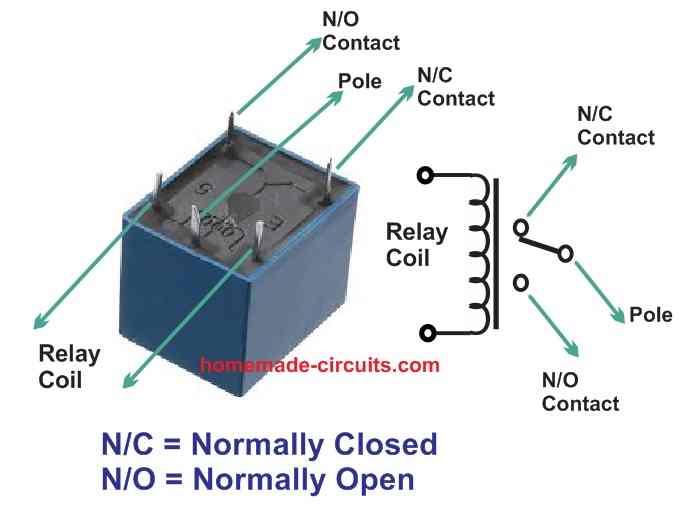
" rel="ugc">
Sir can we use 555 ic for delay on time for this circut, if we can then plz guide me how we can attach with this circut?
Hi Ghulam,
Yes it is possible, I will draw a new diagram and let you know once it is done.
Sir can i use tip147 instead of tip127?in local market i am not foumding tip127,
Hi Ghulam, TIP147 will work but can be expensive….actually you can try 2N2907 or BD140 also, since the load is just a relay coil which may not consume more than 150 mA.
Likewise you can also use a 1N4007 instead of 1N5408.
Sorry for the confusions.
Sir i tried with 2n2907, bc557 and tip 147, delay timer with 555 ic is working, but if i increase or decrease voltage load not disconnect, from the start no voltage on 555ic, slowly its increase at per given capister and resister to 555, but while unplug the power and imidiatly on, delay working well, only through pnp transister not cuttoff, if i increase or decrease voltage, 2n2907 or others base and emiter , collecter voltage 0.7, and on ic given voltage like low or high, i dont know how to solve this issue, sir is it possible for you plz try from your side plz
Hi Ghulam, as I explained in one of my previous comments, the pnp will switch off only when the voltage from the opamp output at its base is equal to its emitter voltage.
First Please measure the voltage across the emitter of the pnp and ground.
Next disconnect the base from the D5, D6 cathodes and measure the voltage between D5, D6 cathodes and ground….The above two voltages must be equal
Please do this and let me know…
Sir i checked on pnp emitter voltage is 15.7, main voltage 16volts, and ground to cathode of d5 and d6, there is no voltage, pin 5 and pin 3 voltage diffrent, pin 5 getting 5.7, and pin 3 getting 3.7, sorry to disturb you again and again on only 1 project, but i cant understand where i am wrong, plz dont mind plz
I tried this same circut with capister its working but with preivious issue…..
Hi Ghulam,
You can post as many questions as you want, it’s not a problem for me, if it is possible i will try to solve them.
The junction of D5, D6 will be positive only when one of the opamps output become high, and that will happen only when the input voltage is an overvoltage or low voltage, depending on the settings of the presets P1 and P2.
I think you have already confirmed the high/low voltage working of your circuit, right?
You can again confirm the above by using a variable power supply input.
I think we forgot one crucial thing….the 555 IC will burn if the supply voltage exceeds 18V, so we have to add a 7812 IC in the circuit.
Please do the modifications as per the following diagram, i have added all the necessary LED indicators which will quickly tell you whether your circuit is working correctly or not:
" rel="ugc">
Sir i modify the circut with 7812, but i used 2n2907 instead of bd140, its working, but what i m facing, once conne t the 30 amp relay voltage drops drops, 16.5 to almost 11.6. Isit normal?
Ok, good… so are the 3 LEDs responding correctly?
Please check the overvoltage and low voltage cut-off and delay time without the relay connected.
And also please tell me the coil resistance of the relay, check the relay coil resistance by removing the relay from the circuit completely, I will try to solve the voltage drop issue.
Sir one thing more, i connected on 555 ic led for indicate to on, that led works well, while decrease or increase voltage cuttoff working good, but when i connected power relay goes on, when delau timer led on relay goes off, may be i mistake, plz guide, i checked on nc and no point both, on nc point relay on then timer on relay off, but no all time relay on, how to check relay coil resistance?may be this project not in my range…..but i will try again n again with your support plz
Ghulam, Please check the diagram again, especially the 555 section:
" rel="ugc">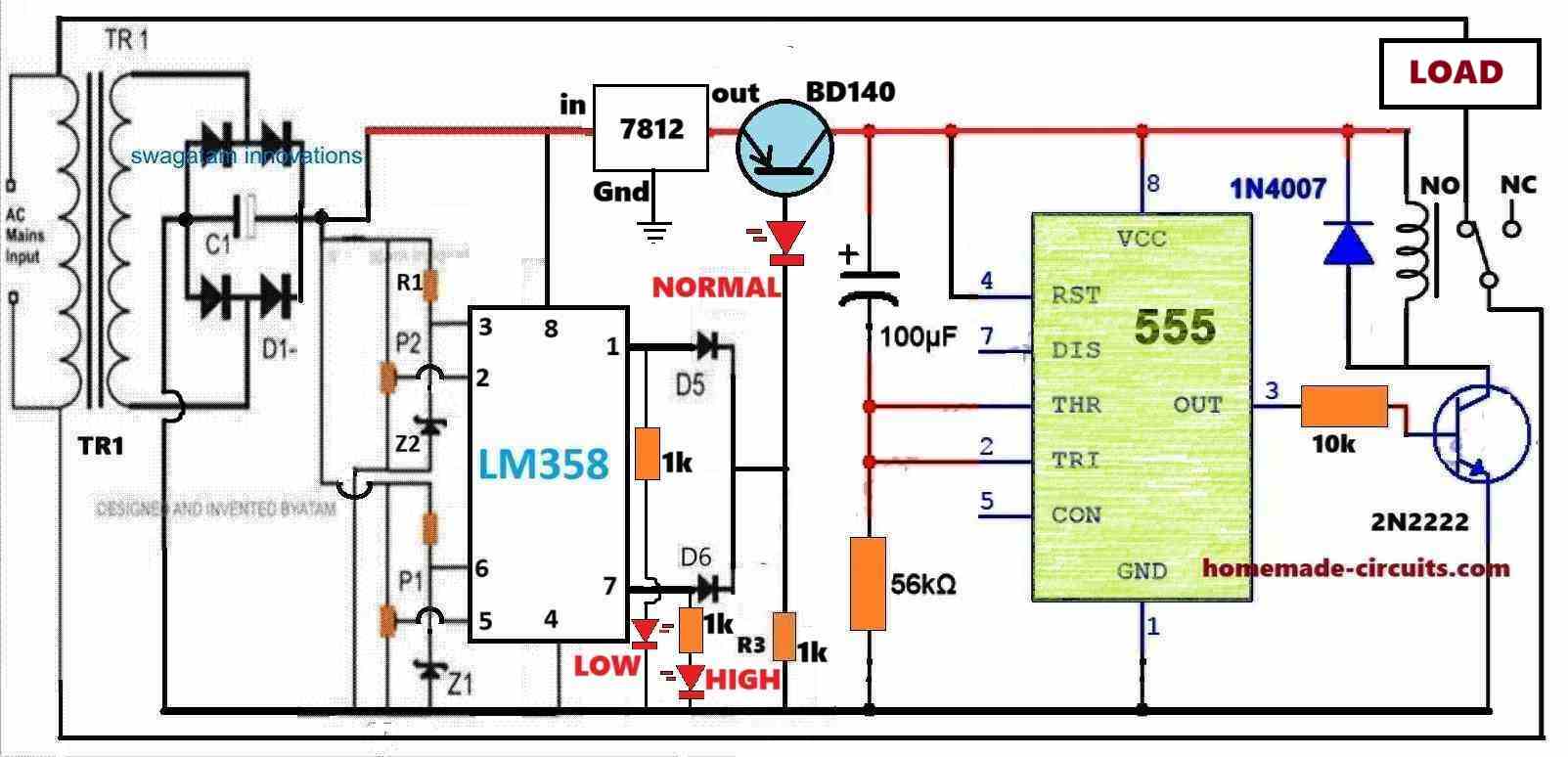
You can see the pin#6 and pin#2 are shorted and connected to the junction of 100uF and the 56k resistor….if you do this correctly then the relay must switch ON only after the initial delay period is over, meaning only once the 100uF has charged fully.
I think you have already confirmed this 555 circuit separately, right?
Sir i will make this circut again on new pcb, hope it will work fine, actually i used bc547 with 555 ic base pin 3, with 10k, i think here we have to use bc 557,suggest me plz
Hi Ghulam, BC547 is correct, because you can see pin2 is connected with capacitor 100uF, that means when power is switched ON, the pin2 will be High through the 100uF capacitor causing pin3 to be low initially, which will keep relay off and the load off…Once the 100uf charges fully after the delay, pin2 of 555 will become low causing the relay to activate and also the load….I think you have connected the load to the NC Contact of the relay…
Hi sir, you are the best best best ever teacher. I don’t have words to say thanks. But i am very happy and lucky i have teacher like you. A lot of thanks
i maked in new zero board and now its working fine without any issue, voltage also stable, and delay timer is also working fine, i used 220uf 16volt and 100k resister and delay time almost 30sec.
Now plz guide me about overload/ over current protection also,
One thing more sir can we use transformerless power supply, if yes then plz guide me about parts values and diagram plz,
Thank you Ghulam,
I am glad " rel="ugc">the circuit is working for you.
Yes, transformerless is also possible with overload protection, I will try to design it soon and let you know.
Thank you sir, i am in waiting plz
Hi Ghulam,
Please try the following modification in your existing circuit for implementing the overload, over current cut-off.
If it works correctly then we can proceed with the transformerless version:
" rel="ugc">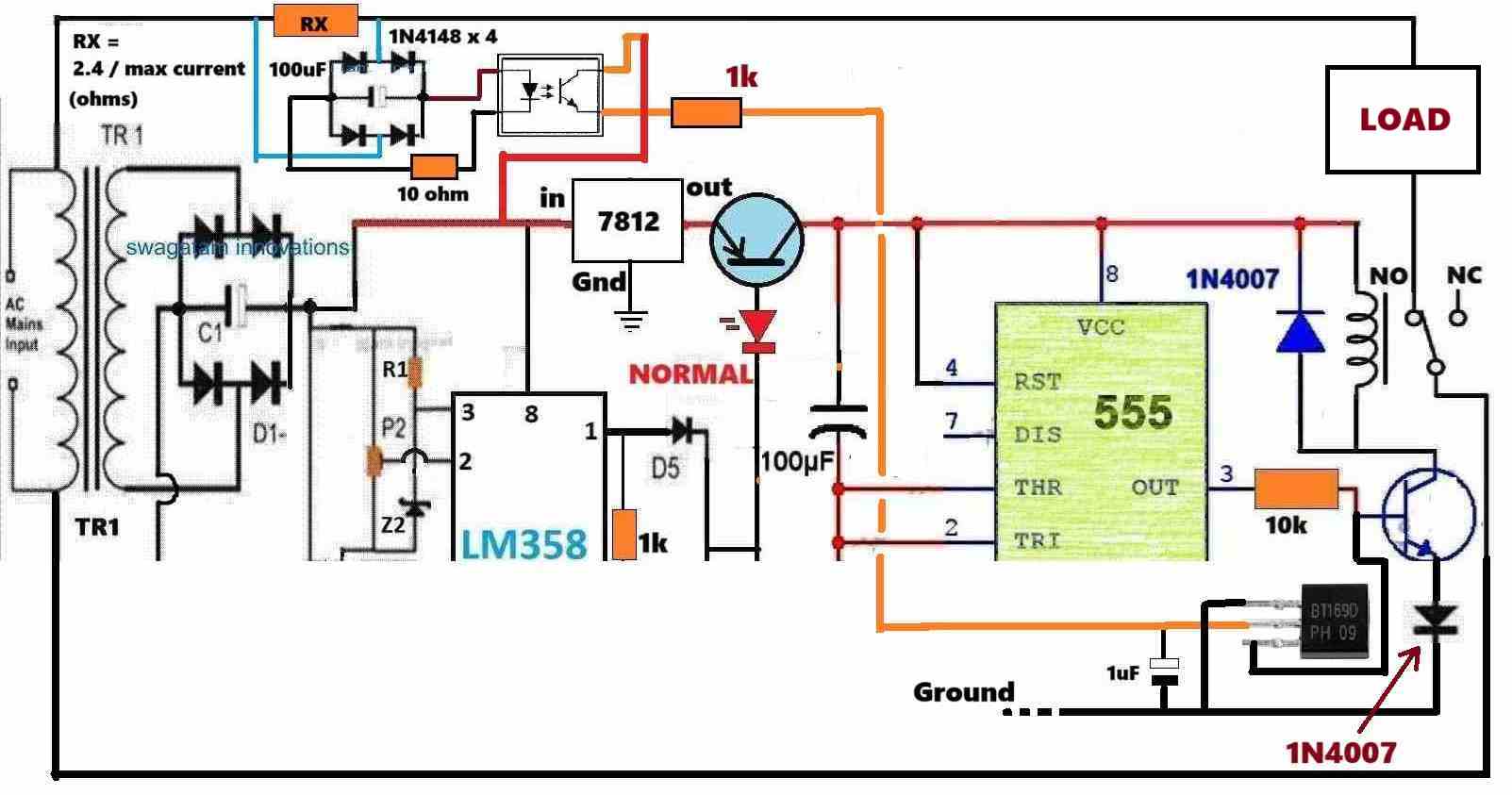
Thanks sir, sir plz guide me about parts, i couldnt get, first from ac you right RX 2.4/max current ohms) what is this, its resister? And 2ndly 10ohm and from in4148 which part is this? Is c106 scr? I searched on google c106 scr is with 3 legs, or scr c106 is connected with 100ohms and 100uf? I a sorry but its new for me, plz dont mind, then i wil arrange parts, and 10 ohm and 100 ohm resistance is normal or in watt?you connected 1 diode with red (3rd)led is in4007, or in 4148?
Hi Ghulam,
Yes RX is a resistor.
If suppose 10 amp is the max current at which the circuit should cut off, then RX can be calculated as below:
RX = 2.4 / 10 = 0.24 Ohms
RX wattage = 2.4 * 10 = 24 watts.
That part is opto-coupler, you can use PC817.
Yes, C106 is an SCR…but you can use any other small SCR such as BT169.
SCR is not connected with 100uF….it is connected to the cathode of the diode, just after the “normal” LED….
all the resistors are ordinary 1/4 watt resistors.
The diode after the “normal” LED can be a 1N4148
Sir can we use bt136 instead of bt169?
BT136 is a triac, so i don’t think it will work correctly in this specific application. BT169 is an SCR, so only an SCR is recommended here.
Hi sir, sir in local market i am not founding bt169 and scr c106, ao i am going to make oeder online, i need to confirm if we make this overload for more than 10amp, because i am using 30amp relay, so in that case scr c106 will support or any other scr? If anything we need to change in this then plz inform me, i will add that component also plz….
Hi Ghulam, The SCR is not responsible for handling the load, it is only for switching OFF the PNP transistor…the load is handled only by the relay contacts, and the RX resistor.
So you can use any small SCR.
The cut off current can be adjusted by calculating the RX value correctly as previously explained by me.
Hi sir, sorry for delay from my side, sir i got bt169 scr, and RX is 2.2 ohm and 3.3 ohm,i tried with 2.2 ohm resistance, what i found led 3 which is connected pnp 2n2907 base is fused there connected with led negative in4148 and 1k resistance while power connected, so i am confused may be i connected some thing wrong, please can you update diagram with bt169 with pin name and number like 1 2 3 as well. Plz
Other thing how i can make sure like circut is working or not, after connected power supply, led 3 fused but after delay load is on, i connected 60watt bulb. Plz guide me how to check weather its working or not plz
Hi Ghulam, please try the following configuration using DC supply to the load:
" rel="ugc">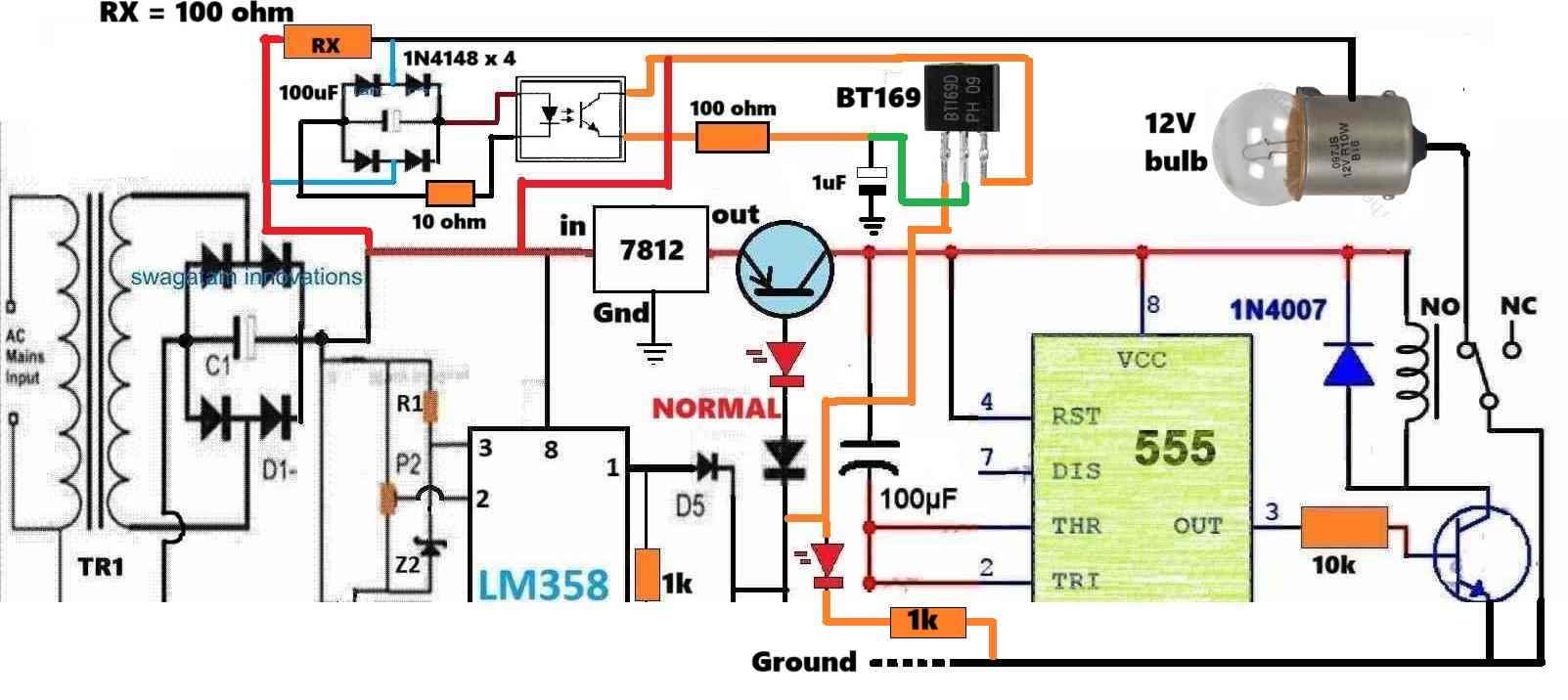
If the bottom side LED illuminates it means the current control is working otherwise something may be incorrect in our setup.
Sir i tried and bottem led with 1 k resister is continusly on with 3rd led . I used RX as 100ohms, after delay relay also on, when i conected normal 12 volt led with less amp, its on with relay coil, but once i conected with rx resister and relay no, led not on but relay on, i have one 12 volt moter which i found from kids electric bike, moter is working with 1 amp adopter, that moter i connected with rx and relay no, relay goes off,
When i removed moter circut not auto restore, i think this option also in this circut once load in the range relay auto on, this is what i found, now i dont know my connections are ok or not, plz guide me
Hello Ghulam, I cannot understand your English, please write it again in correct English.
The 100 ohm is intentionally selected to be high so that the 12V bulb causes an instant overload and the SCR switches ON.
SCR once switched ON will latch (lock) permanently and will need to be reset only with another push button.
If the bottom LED is ON that means the SCR is latched, in this situation, the “NORMAL” LED and the PNP transistor must be switched OFF and the relay shoul be also switched OFF.
I am sorry for trouble. Sir i want to say, after all setup when i switch on the power of circut, bottem light and 3rd led is on without load(12volt bulb)attached.relay also on after completing delay time. If i connected the load in this situation botem light and 3rd led on, relay also on. Hope you understand.
Thank you Ghulam,
Please try the following modification in our earlier circuit.
" rel="ugc">
In this circuit the Rx is connected with AC 220V so be very careful.
I have changed the position of the SCR, and connected it with the base of the relay transistor, and have added a diode with the emitter of the relay driver transistor.
I have changed the SCR gate resistor to 1k.
Rx value = 1.2 / load current.
So if your load current is 10 amp then
Rx = 2.4 / 10 = 0.24 ohms
wattage will be 2.4 x 10 = 24 watts.
For testing you can use a 1 amp or any smaller load and calculate the Rx value accordingly.
Please note that as soon as the SCR is triggered it will LATCH UP, and the relay/load will be switched OFF permanently.
To reset the SCR you will need to switch OFF power and switch it ON again.
The SCR latching is IMORTANT, otherwise the relay will switching ON off on off continuously.
Ok sir i will update you soon, sir can we use VR instead of RX fix resister? If yes then which value?RX one side is connected with 220v ac, and the other side with in4148 and relay, sir with relay which point we have to connected (with NO or with coil negative point?
Hi Ghulam, I am extremely sorry, I forgot to show a series LOAD with the N/O cotacts, please check the new diagram below:
" rel="ugc">
Rx value must be fixed resistor, not variable.
May be first cuttoff procedure complete with npn bc547, then use pnp for 555 ic, is it possoble? If possible then how make the connections?
Using NPN to cut off the PNP is not possible, because the PNP base needs positive to cut off which is provided by the opamps directly. If NPN is added then the positive from the opamp output will be inverted and will become negative which cannot be used to cut off the PNP base.
In that case we have to use one NPN at the opamp output then again another NPN to invert it, and then the 555 PNP.
Another idea could be to replace the PNP emitter diode (1n5408) with a 7812 IC, this will clamp the PNP emitter to 12V so now the opamp output will be always higher than this 12V and will cut off the PNP base.
Sir as i told you earlier i am not expert, i am just learning due to that you are facing issue to guide me, but i am trying my best to follow your instruction. So plz dont mind. And plz provide me working diagram, i will try to make…..plz
Ghulam, no problem at all…since you are new, you must understand the working and then build.
the previous circuit will definitely work if you do the procedures step wise
Did you measure the emitter voltage of the pnp and the voltage at the diode cathodes after disconnecting the pnp base, as suggested by me earlier?
Please do it to find out why the pnp is not cutting off when the opamp output is high.
Hi Ghulam,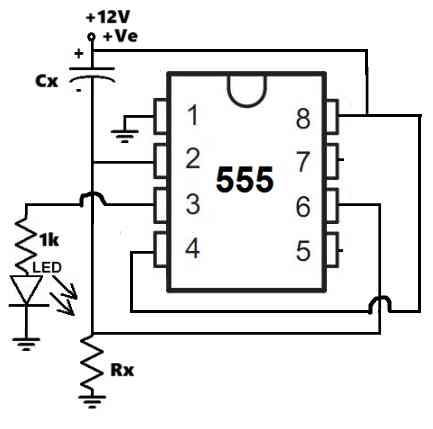
please try the following circuit separately, and check whether the LED turns ON after some delay or not when power is switched ON.
The Rx can be 1M, and Cx can be 100uF/25
" rel="ugc">
Sir i tried like pin 8 and 4 short and 2 and 6 short, then 100k resistance with 6 and 8, 220uf 16volt negative with pin 1 and positive with pin 2, pin 8 positive and pin 1 negative, 1k with pin 3 with led negative and positive with pin 8, its delay time almost 21sec, if i disconnect power and imidiatly connect back its delay same 21 sec, if i used 1m instead of 100k delay time almost 3mint 35 seconds,
I think this can work, guide me how to connect with this circut, and sir i dont know whats happen when i connected relay voltage drops 16 to 13volts and its flacutate, plz guide me where is the problem, i changed transformer also but same,
Hi Ghulam,
that’s great, it means the 555 delay On timer can be effectively used in this home protector concept.
I will give you the fully updated diagram tomorrow.
The 16V to 13V drop when the relay activates is normal, but if it fluctuates then it is not normal.
What about the LED1, LED2 are they also fluctuating?
Yea air low voltage led blink while connected or remove power, i connected 10uf 25volt cap pin 2 and 5…i am waiting for updated diagram plz
Hi Ghulam, please check this circuit and let me know whether the 555 delay ON works correctly or not: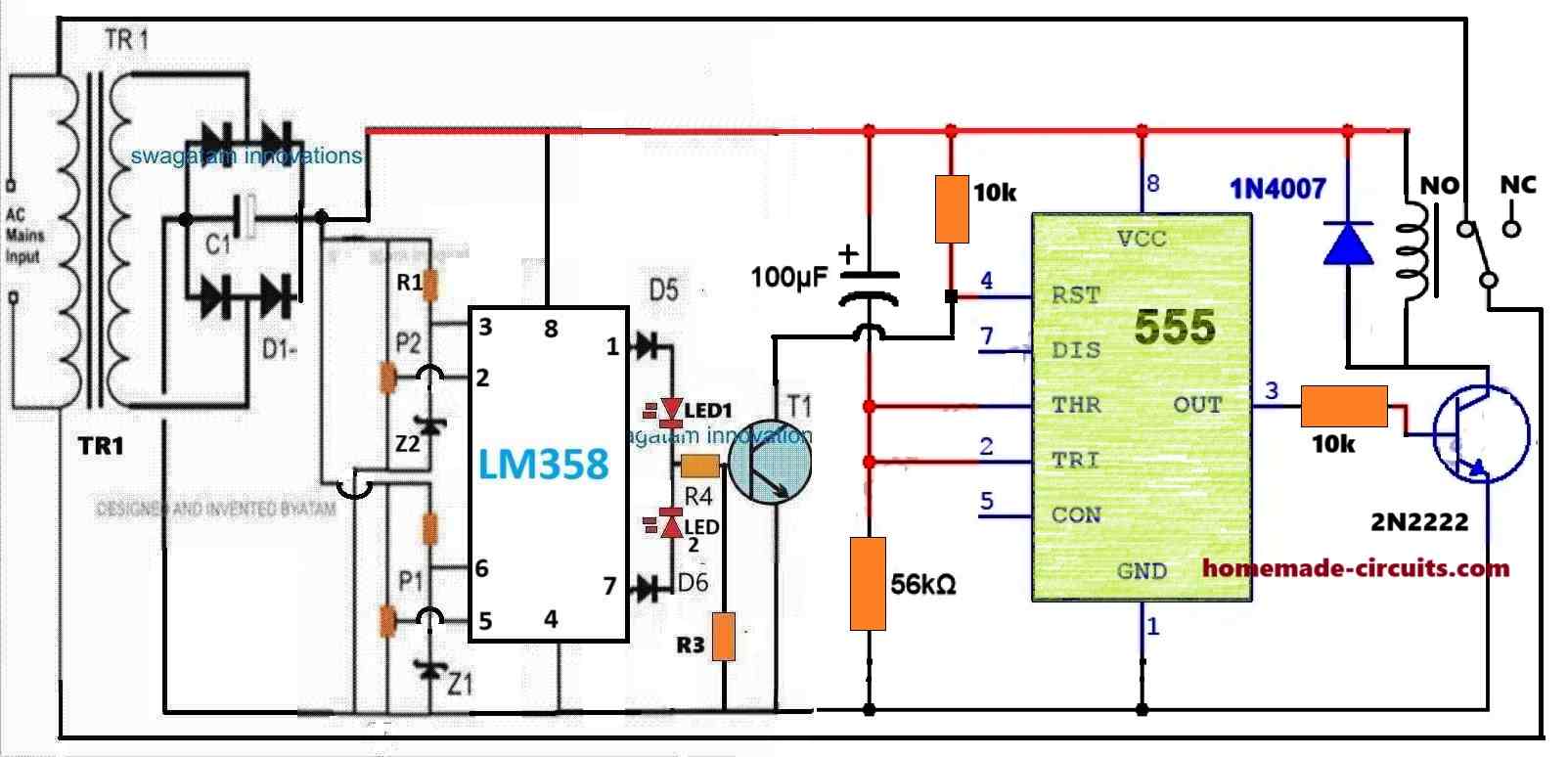
" rel="ugc">
Regarding the voltage drop, please remove the relay and measure its coil resistance and let me know about it.
Hi sir, sir i tried with 555 ic as per your diagram, but cut off function not working. Then i tried with ssr, with same previous diagram, its working well, only discharge issue is there, plz solve this issue and also provide me over current protection. Like we can set amp and once cross to our set level, load disconnect,
Hi Ghulam,
You have tested the 555 circuit separately, right, and you said it worked perfectly, so it should work in the circuit also.
I think the pin#4 connection is not appropriate, I will have to use a different approach using two transistors.
I will update the diagram to you tomorrow.
Unless the delay time is solved the overload/overcurrent cannot be used, so that can be implemented once the capacitor discharge feature is solved.
Sir can we use pnp instead of first npn, actually what i guess we are giving positive to 555 from main, if we use pnp then thorugh pnp we can give positive to 555. May be then cuttoff works, however if not possible then i am waiting for your suggestion and updated diagram.i want to make its perfect plz
Hi Ghulam, you are absolutely correct, but remember to turn off the pnp transistor through the opamp led1, led2 outputs, this voltage at the base of the pnp must be equal to its emitter voltage, which is not the case.
The emitter voltage could be around 14v, whereas the output from led1, led2 could be around 11v, so the pnp will never turn off…so we have to fix this first, I will give you the circuit diagram tomorrow…
Hi Ghulam,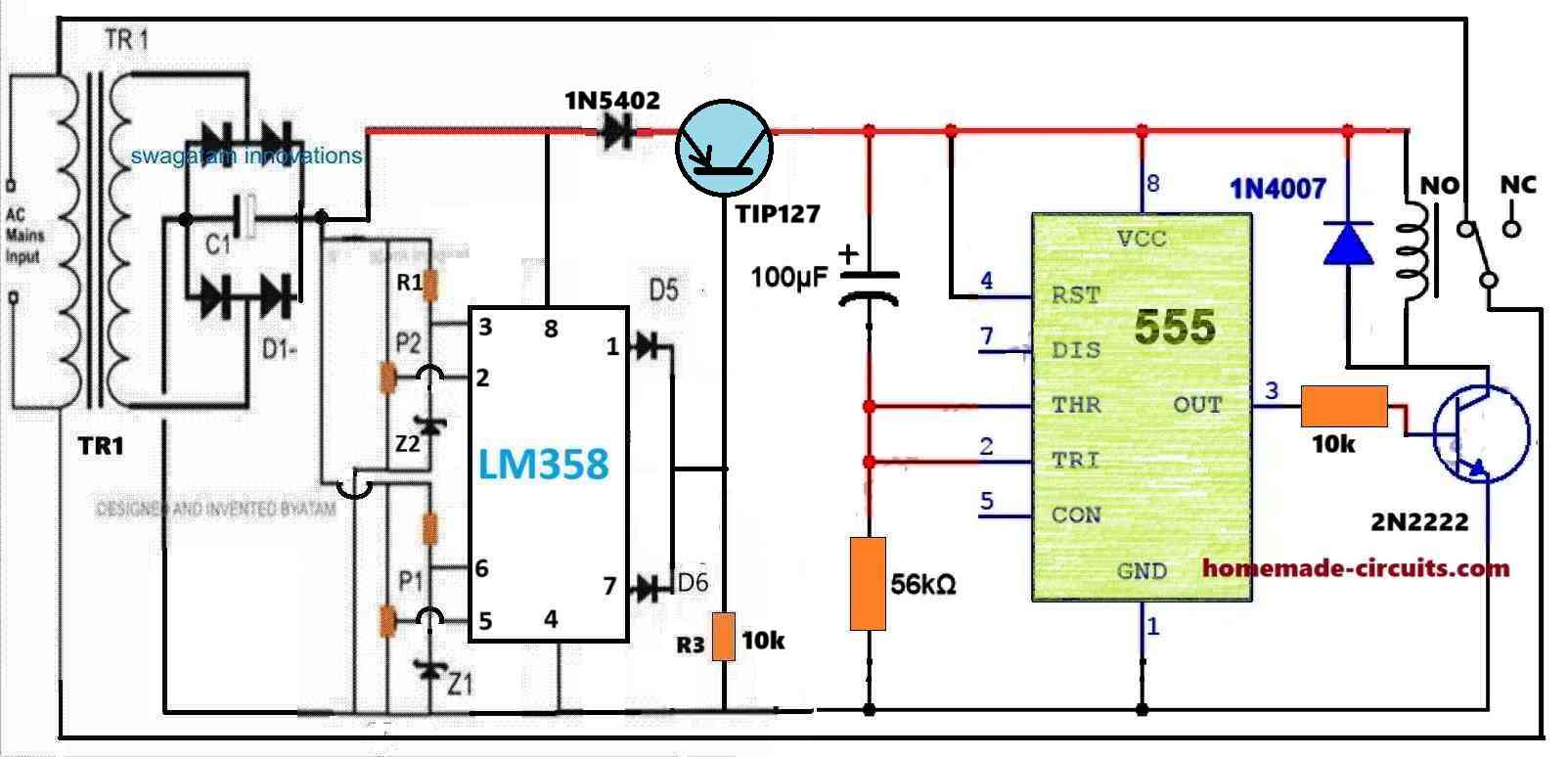
I have designed the new circuit with the PNP switching transistor, you can check it below:
" rel="ugc">
I have removed the LED1 and LED2 from its previous positions.
You can connect them across pin#1 and ground, and pin#7 and ground.
Make sure to connect a 1k series resistor with these LEDs.
Ok sir i will update you soon, i have to arrange IN5402 and tip127. Thanks a lot
No problem Ghulam, all the best to you…
Sir can i use in5408 instead of in5402?
Yes, you can use it, no problems…
hi sir, updated circuit is done, i couldn’t found 2.4 ohm resister, then i tried with 3.3 ohms, with that worked with almost 60watt load, more than this relay swathed off, but normal led continuously on. as we are using 30amp relay, i want to use maximum amp . what value of resister can we use for this.? plz suggest me also give me diagram for transformerless power supply for this circuit plz
Thanks Ghulam, I am glad the overload cut-off is working now.
For 30 amp relay you cannot use a 30 amp load, you can use max 25 amp load.
I have already given you the formula for calculating Rx value, please calculate it yourself for 25 amp load.
The NORMAL LED is working because the voltage is normal, and the cut-off happened because of overload or over current.
You can confirm the high/low voltage cut-off by supplying an adjustable voltage and check whether the NORMAL LED shuts off or not, if not then your PNP might have gone faulty.
I will try to design the transformerlless version soon, and let you know…
Sir,
Thank you very much for your valuable tips and advice.
Regards V.Sambath kumar
You are welcome Sambath.
Hello Sir,
Your ckt is really good.I also thank Mr Ali for the pain and effort he took to modifie the delay circuit. suggestion fr my side is
1.Led3 to be connected in the same polarity between T2 collector and R8. led 3 better a green one. in course of time improper function of T2 can happen it is good for the BE voltage of T2.
2.Better to provide a100 mfd 25v cap parallel to R7 negative of cap going to the base of T3 to avoid chattering of relay due to power supply variations now it will not be there but it can happen any time.
3.what is the regulated +vcc voltage of the icis it 5v. Are you using a regulator or voltage divider resistor with zener. If we use a12-0-12v transformer we can avoid 2 rect diodes in the pcb to save space and time . A rly 100 ohms / 12v takes 120ma+ other ckts 30 max ie 150ma ,relay is on most of the time so I feel 12v 750 ma is ideal and easily avalible is 12v 1 amp.
Sir these are my suggestions you can correct me if I am wrong.
Regards V.Sambath Kumar.
Thank you Sambath,
I appreciate your suggestions.
The LED3 in the last diagram must be connected with the same polarity as shown. Yes, a green LED would be better for LED3.
You can add a 100uF across base/emitter of T3 for a reliable operation of the relay.
A bridge rectifier is always the best option which allows the transformer to be more compact compared to a 12-0-12V, because in a 12-0-12 trafo an extra 12V winding is used which can make the transformer unnecessarily bulkier.
The maximum operating voltage of an LM358 is 32V which is quite sufficient for the above project.
I think a 12V 200 ohm relay can be used which will have contacts rated at 20 amps, enough for any household electrical application, so a 500 ma transformer should do the job.
Dear Sir Swagatam, hello
Congratulations, Sir
Just two seconds after replacing the 1M resistor with a 10k resistor and connecting the Emitter of Tr2 to an LED (LED3) grounded, Tr3 conducted, and LED3 gleamed simultaneously with 7mA of current.”
The joy that flooded me at that moment was indescribable. It seems that the Emitter of Tr2 was the culprit causing the issue and bothering you a lot, since I had reduced the R5 to 10k earlier and it did not lead to Tr3 conduction. We can now consider LED3 as a Delay-on time indicator.
I extend my heartfelt gratitude for your unwavering support and patience in guiding me through this process.
The replacement of R5 with a 390k resistor successfully achieved a 115 seconds delay-on time, which perfectly suits my requirements. Maybe it is a good idea to publish the whole circuit diagram with it’s modifications in the main article.
please allow me to restate my request to highlight the following sentence ( or similar one in your own literature) prominently in bold and larger fonts for your website visitors: “This circuit performs exceptionally well and is highly recommended for home appliances.”
He who always remembers your kindness and generosity
Truly yours
Ali
Please note: At the time when I uploaded this response, The “Reply” field was off for all comments.
Thanks so much Ali, for updating the information. That’s great!
I am glad you could finally succeed with the delay ON timer circuit stage.
Yes, it was the 3V emitter zener diode and the 1M base resistor which were inhibiting the switch ON threshold of the transistor.
I will surely update the new complete diagram in the article soon, which was tested by you.
I have already put the message as suggested by you. You can find it at the top section of the above article.
I hope you are able to see the reply buttons for every comment now, please let me know if you don’t.
Dear Sir Swagatam
Hello, hope you are doing well
Yes, I can see the reply button now. Once again I thank you for all your assistance and updating the circuit diagram.
God bless you kind and lovely man
Best regards
Ali
Thank you Dear Ali, You are most welcome.
Please keep up the good work. All the best to you.
Dear Sir Swagatam
Hello, hope you are doing well
I have already sent two videos of the circuit’s performance mounted on a breadboard to your email address. I wanted to inform you that I have replaced R5=390K with a 100K resistor to record a short video so that You may consider publishing it on your site, if you wish.
As you may have noticed, when the mobile’s second-hand clock reaches 12 o’clock, I power on the circuit. Time passes slowly and the relay, subsequently the yellow LED connected to its NC pins, and the red LED placed between the T2 emitter and ground turn on after a 17-second delay (delay-On time).
Upon reducing the voltage to 14 volts, the red LED1 turns on, and upon increasing the voltage to 20 volts, the blue LED2 illuminates. That is all. I hope this video will be of interest to your visitors.
I hereby thank a lot Mr. Sambath for his appreciation
With warm regards,
ALi
Thank you so much Dear Ali,
The video is amazing and clearly shows the complete testing procedure for the last updated circuit.
Many thanks to you for your kind contribution!! All the best to you, and please keep up the good work.
…I have updated the video clip in the above article.
Dear Sir Swagatam
Thank you so very much for publishing the video. I am so pleased you like it. in fact, You have embarrassed me with your high praise and thanking for something that I do not consider remarkable. I am very grateful for the kind and generous person that you are, and for helping others with all your heart.
Thank you very much my patient instructor.
Best regards
Ali
No problem Dear Ali, you are most welcome, I appreciate your kind words.
Dear Sir Swagatam
Hello. You have my heartfelt gratitude for the great favor you’ve done for me. I will surely do this project and will share you the result; my dear instructor.
He who never forgets your huge favor and kindness
Sincerely
Ali
You are most welcome Dear Ali,
I wish you all the best, and please share your results, and let me know if you have any further issues or doubts regarding the circuit.
Dear Sir Swagatam
Hello. Hope you are doing well
I would greatly appreciate it if you could kindly advise me on whether I am permitted to utilize a 220/9-0-9 transformer that I currently possess and adjust the 18V output of it to 12V using a 7812 regulator, in place of the 220/12-0-12 volt transformer. will the circuit work well then?
God bless you
Best regards
Ali
Thank you dear Ali,
Sorry, 7812 cannot be used since that would prevent the circuit from detecting the high low fluctuations.
However if you use a 9V relay then the 0-9V tap could be utilized for powering the circuit.
All the best to you, let me know if you have any further questions.
Thank you so much for your kind response, dear Sir Swagatam
I will definitely share the results
Best regards
Ali
You are most welcome Dear Ali,
Dear sir Swagatam
Hello. I am pleased to share that I have successfully assembled the circuit under title “Mains AC Home Protector Circuit” and it is functioning well. I want to express my gratitude for sharing such a wonderful circuit diagram.
After connecting the circuit, which was mounted on a breadboard, to the 15-volt rectified output of a 220/12v transformer, I had to adjust P2 slightly until the relay connected. Turning the P1caused the relay to switch off, indicating that the circuit is working perfectly.
The only challenge I encountered was that the commercial version I previously had, took a few minutes delay to power on the appliances when connected to the mains supply, a feature that I did not observe in your circuit design. I would be very glad if you please inform me how to solve this issue.
Thank you once again for providing this great circuit diagram, and for all your kindness too.
Best regards
Ali
That’s great Ali, thanks so much for verifying the results of this circuit.
Actually the parts R5 and C2 are specifically positioned to generate the intended delay on effect whenever the circuit is turned on.
When power is switched ON, C2 prevents the base of T2 to get the 0.6v biasing supply and keeps it turned off for sometime until C2 is fully charged via R5. However to compensate the presence of D8 we must add another diode in series with the emitter of T2, that should solve the issue and you should be able to get the initial switch on delay.
So please add a 1N4148 diode in series with T2 emitter, or maybe to further enhance the delay effect you can add a 3V zener diode in series with the T2 emitter, cathode of the zener will connect with the T2 emitter and the anode with the ground….let me know how it goes…all the best to you.
Dear Sir Swagatam
I hope you are doing well.
I am writing to share the results of the task you assigned to me. Here is what I have done based on your instructions:
1. I connected a 220V lamp to the relay and then plugged the circuit’s input into the mains supply. I adjusted P2 until the lamp turned on. Subsequently, I removed the wire that connects the emitter of Tr.2 to the ground and inserted a 3.0V Zener diode between the earth and the emitter of Tr.2. I waited for 20 minutes, but the lamp did not turn on. I then replaced the Zener diode with a 1N4148 diode and found that the result was the same as with the Zener diode. By adjusting P2 slightly, the lamp turned off, and rotating P1 caused the lamp to turn on.
2. Rotating P2 caused the lamp to turn off, and the output of pin 7 of LM358 was approximately 15V. Further adjustment of P2 resulted in the lamp turning on, with the output of this pin dropping to zero volts. Simultaneously, the output of pin 1 of LM358 IC also read zero volts. After adjusting P1, the lamp turned off, and the output voltage of pin 1 of LM358 was around 15 volts.
The circuit appears to be functioning correctly, but there is a particular issue that I am confident you, my esteemed instructor, Sir Swagatam, will be able to resolve.
Please excuse me for bothering you
I sincerely appreciate your kindness and assistance.
Thank you.
Warm regards,
Ali
Thank you Dear Ali,
I appreciate your efforts, however the setup procedure is a little elaborate and needs some thorough practical experimentation using a variable power supply.
Please refer to the above article, I have comprehensively explained how the presets P1, P2 needs to be set up and how the delay ON timing needs to be confirmed.
Please start reading from “Calculating the Tripping Points” and the full description that follows.
I have also updated the article with a new diagram with various LEDs for the appropriate indications.
Please let me know if you have any difficulty understanding the procedures.
Dear Sir Swagatam
Hello.
I would like to express my heartfelt gratitude for your detailed and thorough instructions on setting up the circuit. Your guidance was invaluable, as I had never encountered such procedures before. I appreciate the time you took to modify the circuit diagram and provide understandable detailed descriptions. Your willingness to assist visitors on your site is truly commendable.
Following your instructions, I successfully completed all nine steps using my 35V 3A bench power supply. However, I encountered a slight issue during the last step. ( This section of the article: As you lower the voltage, keep going until it reaches around 14V. At this point the LED1 should instantly turn ON, turning off LED3 and the relay (back to N/C point)) .LED1 was supposed to turn on when the voltage decreased to 14V from 19V, causing LED3 and the relay to turn off. Instead, this occurred at 16V. After that I adjusted P2 slightly, and LED1 turned on at 14V, and LED3 and the relay turned off after one second. Is there a reason for this?
I kindly request that you emphasize the following statement in bold and larger fonts: “This circuit performs incredibly well and is highly suitable for home appliances.”
I have a query my esteemed instructor: How can I extend the delay-ON time for the circuit to one minute or longer after connecting the circuit to the mains supply? By “delay ON time,” I am referring to the time it takes for a specific appliance to turn on after the circuit is powered on.
Once again, I am deeply thankful for your kindness and support.
Yours sincerely
Ali
Thank you so much Dear Ali for confirming the setting up procedures.
I think the LED1 turned ON at 16V because of a discrepancy in the P2 setting, because setting with an ordinary preset manually may not be accurate. I think you can try replacing the presets with multiturn presets, that would perhaps help you to get a much more accurate results from the presets.
You also said that LED3 and relay turned OFF after 1 second, this should not happen, because there’s nothing that would hold the LED3 and the relay for 1 second…If possible please investigate this issue from your end.
Regarding increasing the delay ON period of the relay, can you please specify why do you need this increased delay because a 1 or 2 second delay is actually enough to mitigate the switch ON surge hazard?
Prolonging the delay ON time would cause an unnecessary delay for the appliances to be turned ON, each time mains power is restored?
I will surely include the message in the article, as suggested by you, thank you for the suggestion.
Please let me know if you have any further doubts or queries.
Dear Sir Swagatam
Hello. Hope you are fine and healthy
I am writing in reference to my previous letter regarding the issue with LED1 turning on at 16V instead of the specified 14V. I am pleased to report that I have replaced both 10K pots. with multi turn ones. Upon setting and testing, I observed that while decreasing the voltage from 19V, LED1 illuminated precisely at 14V, in accordance with your instructions. Additionally, LED3 and the Relay turned off, aligning perfectly with your guidance: “As you lower the voltage, keep going until it reaches around 14V. At this point, the LED1 should instantly turn ON, turning off LED3 and the relay (back to N/C point).”
Regarding the significance of the delay-ON time, I would like to bring to your attention the frequent power interruptions experienced in my city. We face electricity cuts a few times every month, often resulting in severe fluctuations upon restoration. As a precautionary measure, most commercial mains protectors are sold here, delay the power supply to appliances for a few minutes after reconnection to mitigate the impact of these fluctuations.
Thank you very much for your favor and kindness
sincerely yours
Ali
Thank you so much Dear Ali,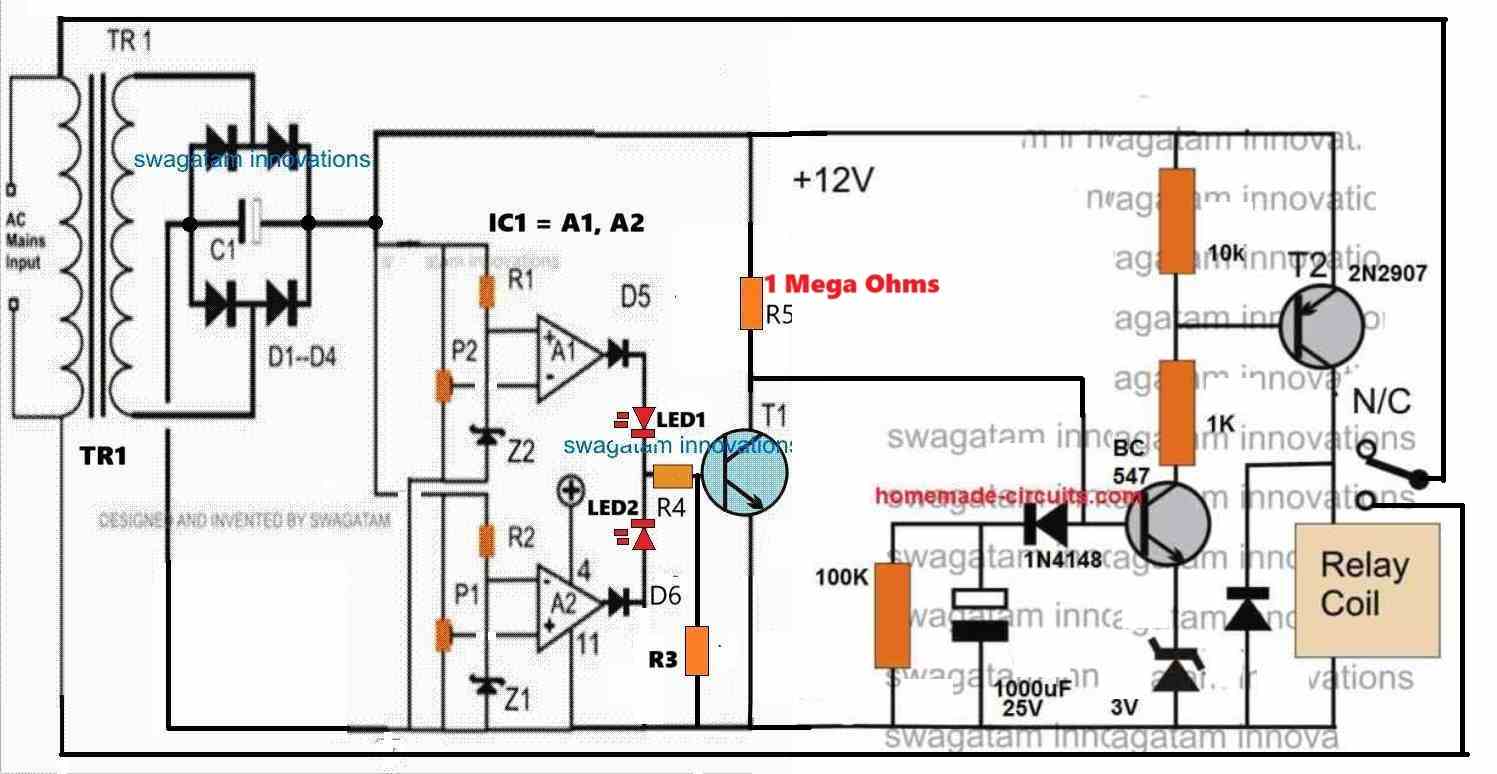
I am glad you could adjust the presets correctly.
Now I understand the need for a long duration delay ON protection, it completely makes sense now.
I have tried to design the 1 minute delay-ON facility in the circuit, you can find the updated diagram in the following figure:
" rel="ugc">
You can change the 1M resistor value and the 1000uF capacitor to tweak the delay ON period.
Also, I could not find a proper place to add the green LED, I think it can be added parallel to the relay coil with a series resistor.
Let me know if you have any further questions.
Dear Sir Swagatam
I hope you are doing well. Words are too weak to express the ultimate gratitude and thankfulness for your extreme favor in redesigning the circuit. Please accept my heartfelt thanks.
After purchasing a few 2N2907 transistor today, I assembled the circuit according to your new modifications. Unfortunately, it did not work; the relay did not connect even once. Replacing components related to the modified part of the circuit proved to be futile.
I reduced the 1 Mega ohm resistor to 100K and lower, but it didn’t work. There was no voltage across the 3V Zener diode either.
I reverted the circuit to its previous design, and it started working perfectly.
Please forgive me for bothering you and taking up your time. I am unsure if adding a simple timer circuit to the existing circuit, which is currently functioning well, is a good idea.
I will always remember your kindness.
Sincerely yours
Ali
Thank you Dear Ali, and sorry about the trouble you are facing.
I would like to tell you that the new circuit with longer delay time will surely work, you just have to do two things.
Replace the 3V zener diode with a 1N4148 (Cathode to ground) and tweak the 1M to some lower value.
However, I am glad the whole circuit is overall working for you.
Also I wanted to inform you that currently my site transitioning to a new host, so some comments might not be published during this period. Things will resolved within a couple of days.
Please keep up the good work. All the best to you.
Dear Sir Swagatam
Hello. Hope you are fine
I did both of your instructions diligently, carefully checked the wiring multiple times, and even substituted the circuit’s relay with an LED. However, the 2N2907 transistor did not conduct at all. I also experimented with it’s equivalents, including the BC327, 2N2905, and S9014, and as a last resort, removed the 1MR resistor. Regretfully, the result remained unchanged. I can only guess that the issue may lie in the potential defectiveness of the transistors though they were all new. It is my hope that assembling the components on a circuit board in the future may solve the problem.
“I am immensely grateful for your unwavering support, invaluable guidance, and the time you dedicated to responding and designing the complementary part of the circuit as per my need and request.”
Warmest regards
Ali
Thank you dear Ali, for your kind feedback,
However, i want to assure you that the delay ON timer using two transistors will work without any doubt, and I have tested it myself.
Please do some more modifications to make the circuit very obvious.
Please change 1M to 10k, replace the BC5547 emitter diode with an LED (anode to emitter, cathode to ground).
Let me know how it goes.
Dear Sir Swagatam
Hello, I hope you are doing well and staying healthy. I am grateful for your kind response and for introducing the “Mains AC home protector circuit”. Would you please do me a favor and specify the number of pins on the IC LM324 ( A1 and A2 ) in the circuit diagram?
Thank you so much in advance
Sincerely
Ali
No Problem, Ali,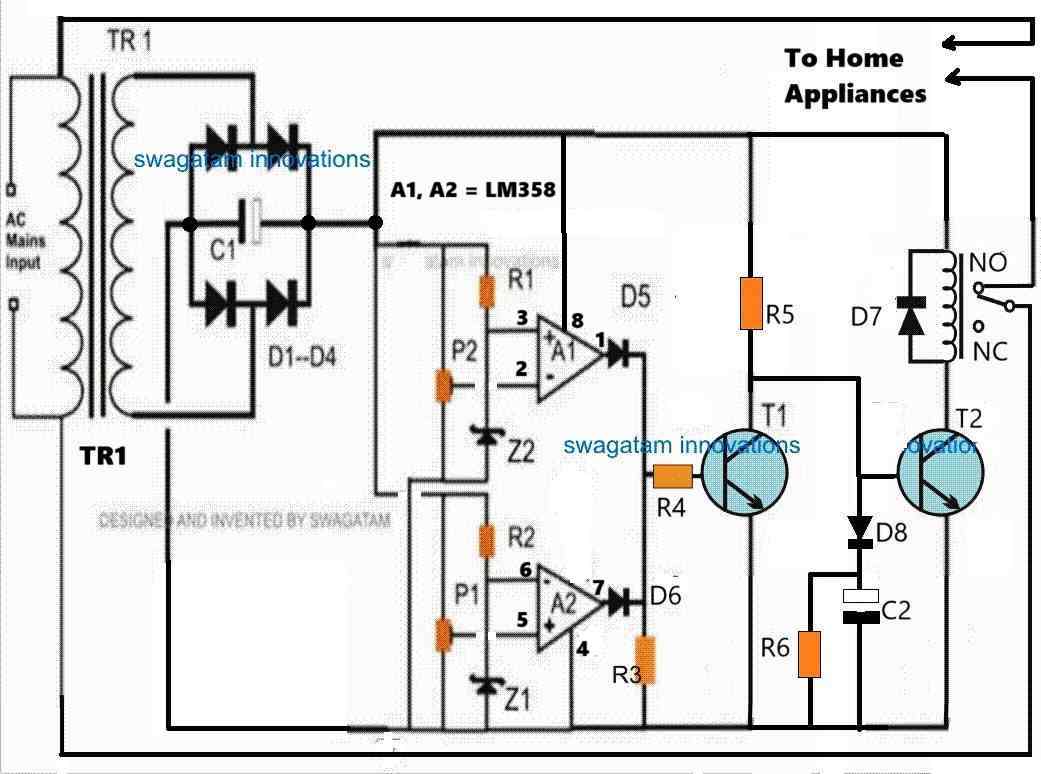
I would recommend using LM358 instead of LM324 since LM358 has two opamps, and we need only two opamps in the design.
Here’s the complete circuit diagram:
" rel="ugc">
What voltages are the zener diodes,z1 and z2
They can be any value between 3v and 6v, 1/2watt.